Folk Art Sketch of Girl With a Whip and a Dog
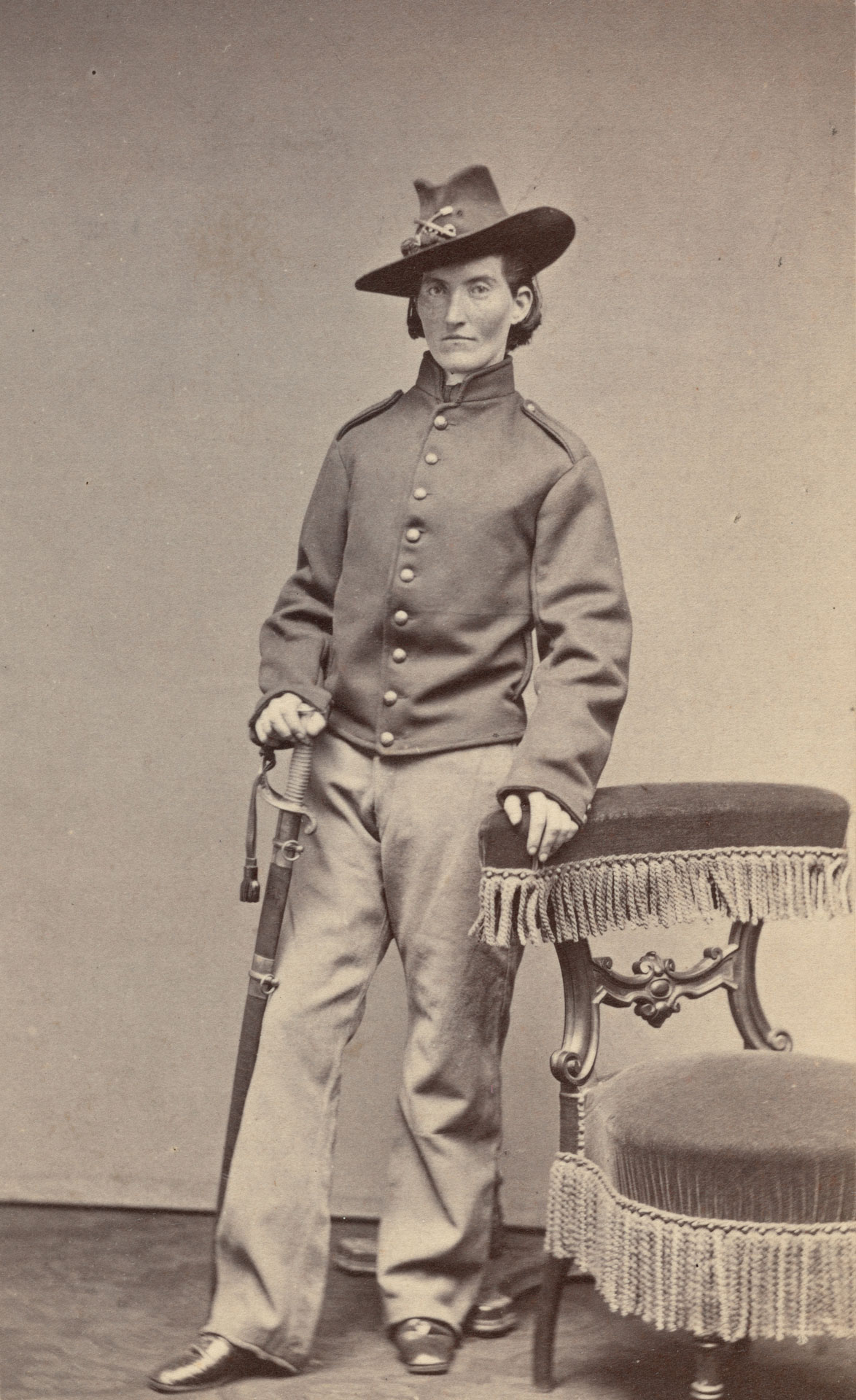
The American Ceremonious State of war (1861–1865) was one of the start armed conflicts documented by photography. Soldiers often had portraits made of themselves earlier they reported for duty. Such images, ofttimes produced in multiples approximately the size of a credit card, were small, portable, and inexpensive—ideal for sharing with loved ones. This photograph, taken in Samuel Masury'due south Boston-based studio, is of Frances Clayton, a Minnesotan farmer and newly enlisted soldier; she is photographed in a Union army uniform. Clayton disguised her sex in club to join the army, which prohibited women from serving. It is thought that she served in a Missouri regiment aslope her husband, who died in boxing. In the U.s.a., women were non permitted to enlist in the military until 1917, during the concluding years of World War I. What does this image reveal to u.s. about gender in the late 19th century? What ideas of gender are debated in the context of the armed services today?
Samuel Masury,
, c. 1865, albumen print (carte-de-visite), National Gallery of Art, Washington, Robert B. Menschel and the Vital Projects Fund, 2019.97.2
1 of xxx

The American Civil War (1861–1865) was one of the offset armed conflicts documented past photography. Soldiers often had portraits made of themselves before they reported for duty. Such images, frequently produced in multiples approximately the size of a credit card, were small, portable, and cheap—platonic for sharing with loved ones. This photo, taken in Samuel Masury's Boston-based studio, is of Frances Clayton, a Minnesotan farmer and newly enlisted soldier; she is photographed in a female gender-conforming dress. Clayton disguised her sex in order to bring together the army, which prohibited women from serving. It is idea that she served in a Missouri regiment aslope her hubby, who died in boxing. In the U.s.a., women were not permitted to enlist in the military until 1917, during the last years of World War I. What does this epitome reveal to us about gender in the late 19th century? What ideas of gender are debated in the context of the military today?
Samuel Masury,
ii of thirty
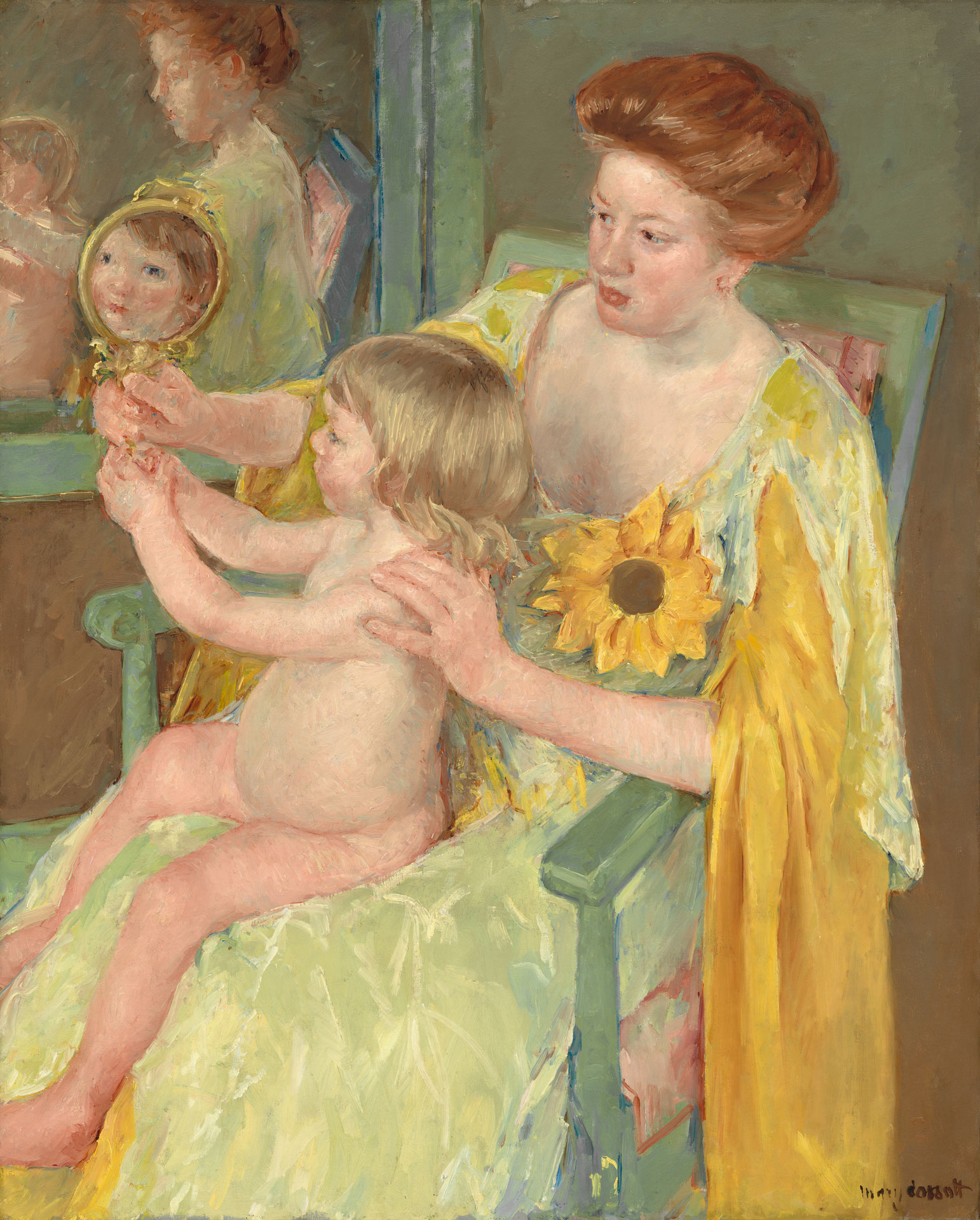
In this painting, Mary Cassatt pictures a mother and child in an intimate domestic scene, maybe in the mother's chamber. The girl's nudity suggests that she may exist fresh from her bathroom. The mother gently supports the child'southward shoulder with one hand, property up a mitt mirror to the child with the other. Notice the multiple reflections produced by the mirrors, and how the artist repeats shapes, forms, and colors in the painting. You may likewise observe the big sunflower pinned to the woman's dress, almost at the center of the painting: it is an keepsake associated with the American women suffragist move. The sunflower appeared on a suffragist badge advocating for women'south right to vote in the presidential election of 1904—about a year before this painting was fabricated. Mary Cassatt was 1 of just three women (and the merely American) to exhibit with the French impressionist painters. This influential art move developed in Paris in the 1860s; the give-and-take "impression" described the artists' intention of capturing moments from everyday life. How might the signal of view of a female artist at this time impact her representation of everyday life?
Mary Cassatt,
3 of 30
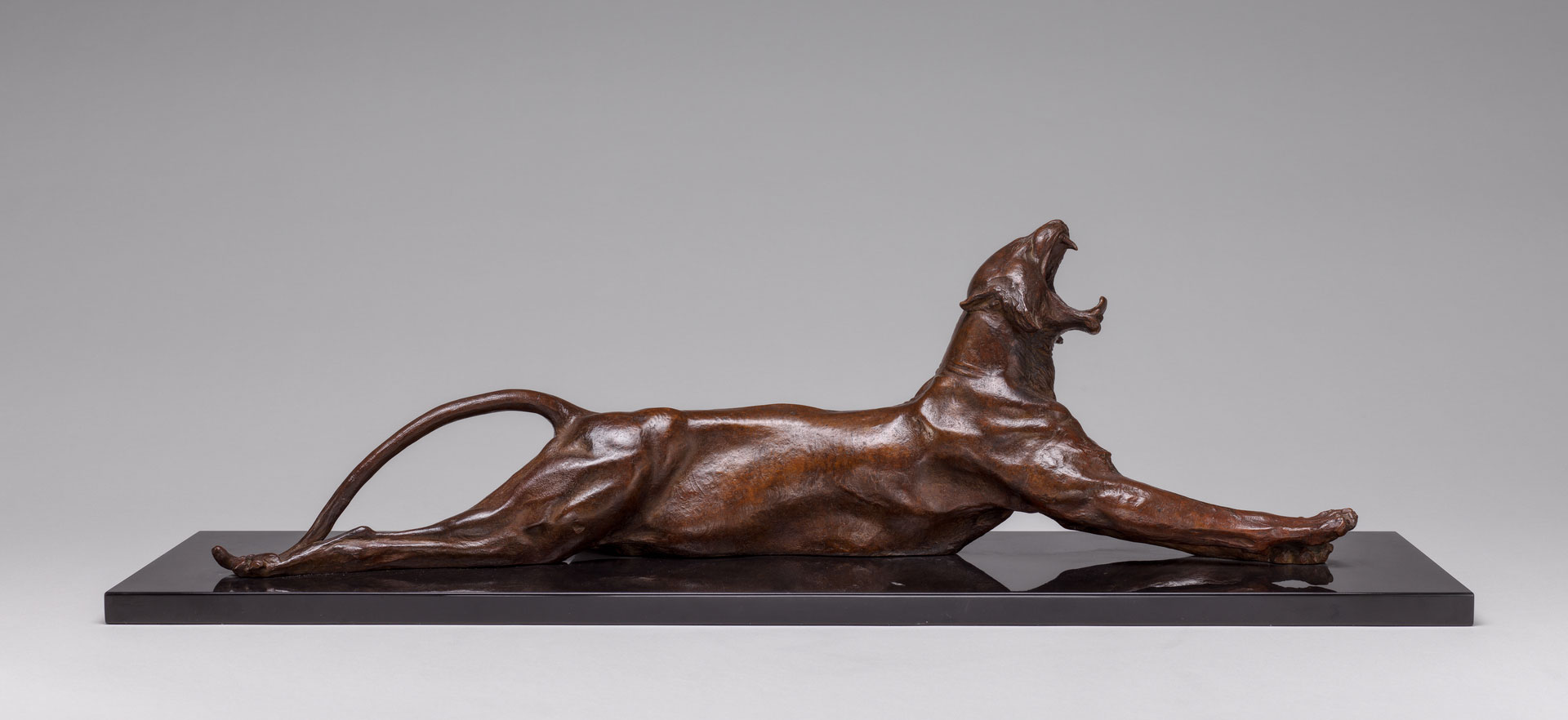
Anna Hyatt Huntington is best known for statuary statuettes of exotic animals. The New York Zoological Park (now the Bronx Zoo) provided the creative person with ready models and she challenged herself to capture the animals in movement, expressing their typical behavior, gait, or posture. Animal sculptures became the mainstay of her career, and she sold numerous casts first to individual collectors and eventually to major museums. Her ambitions grew with her success and she won a commission from New York City for a awe-inspiring equestrian statue of Joan of Arc, a pop symbol of female strength, independence, and suffrage. (The memorial remains on view in Riverside Park today.)
Anna Hyatt Huntington,
4 of thirty
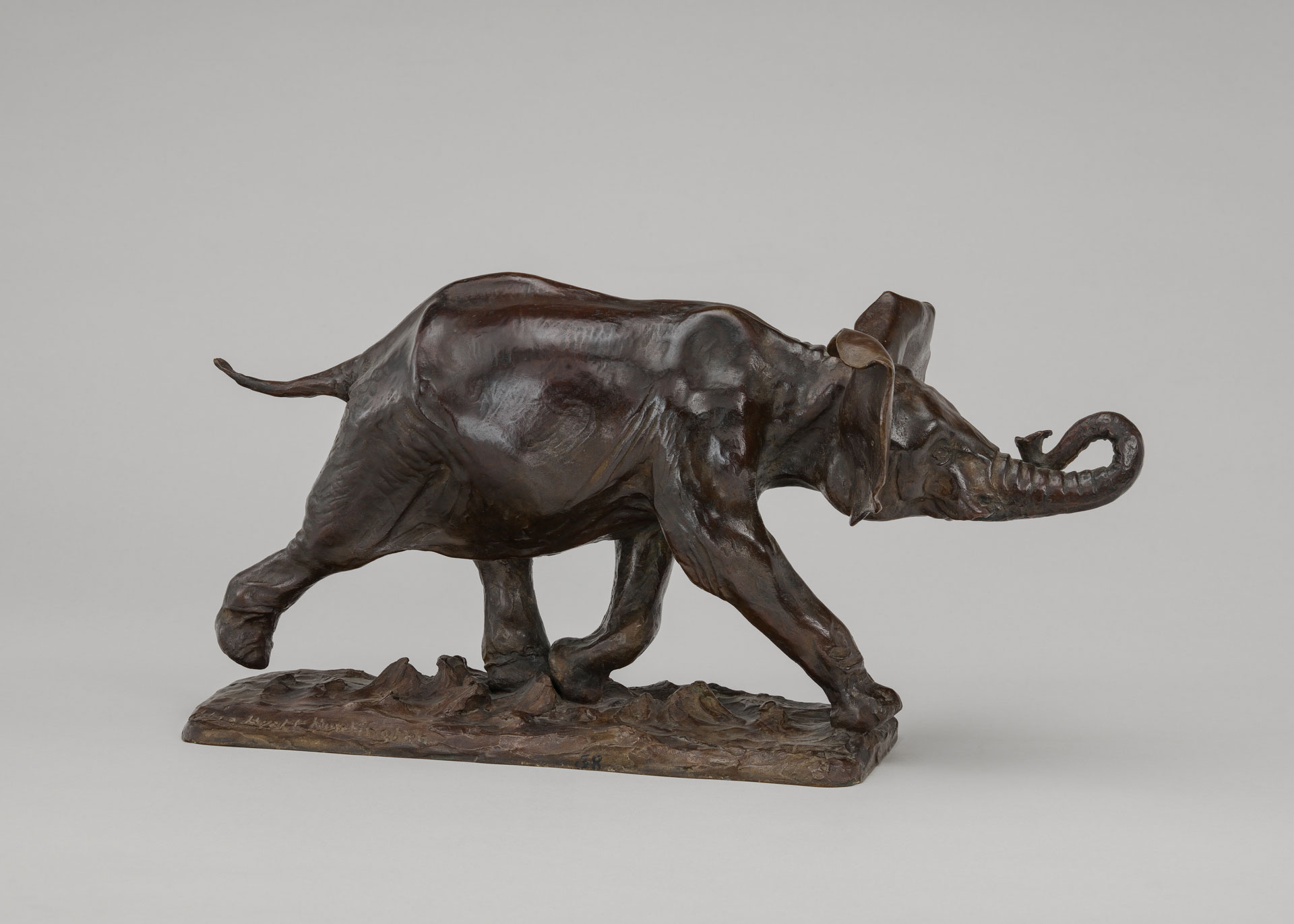
Anna Hyatt Huntington is best known for bronze statuettes of exotic animals. The New York Zoological Park (now the Bronx Zoo) provided the artist with ready models and she challenged herself to capture the animals in motion, expressing their typical behavior, gait, or posture. Animal sculptures became the mainstay of her career, and she sold numerous casts start to individual collectors and eventually to major museums. Her ambitions grew with her success and she won a committee from New York City for a monumental equestrian statue of Joan of Arc, a pop symbol of female person strength, independence, and suffrage. (The memorial remains on view in Riverside Park today.)
Anna Hyatt Huntington,
5 of 30
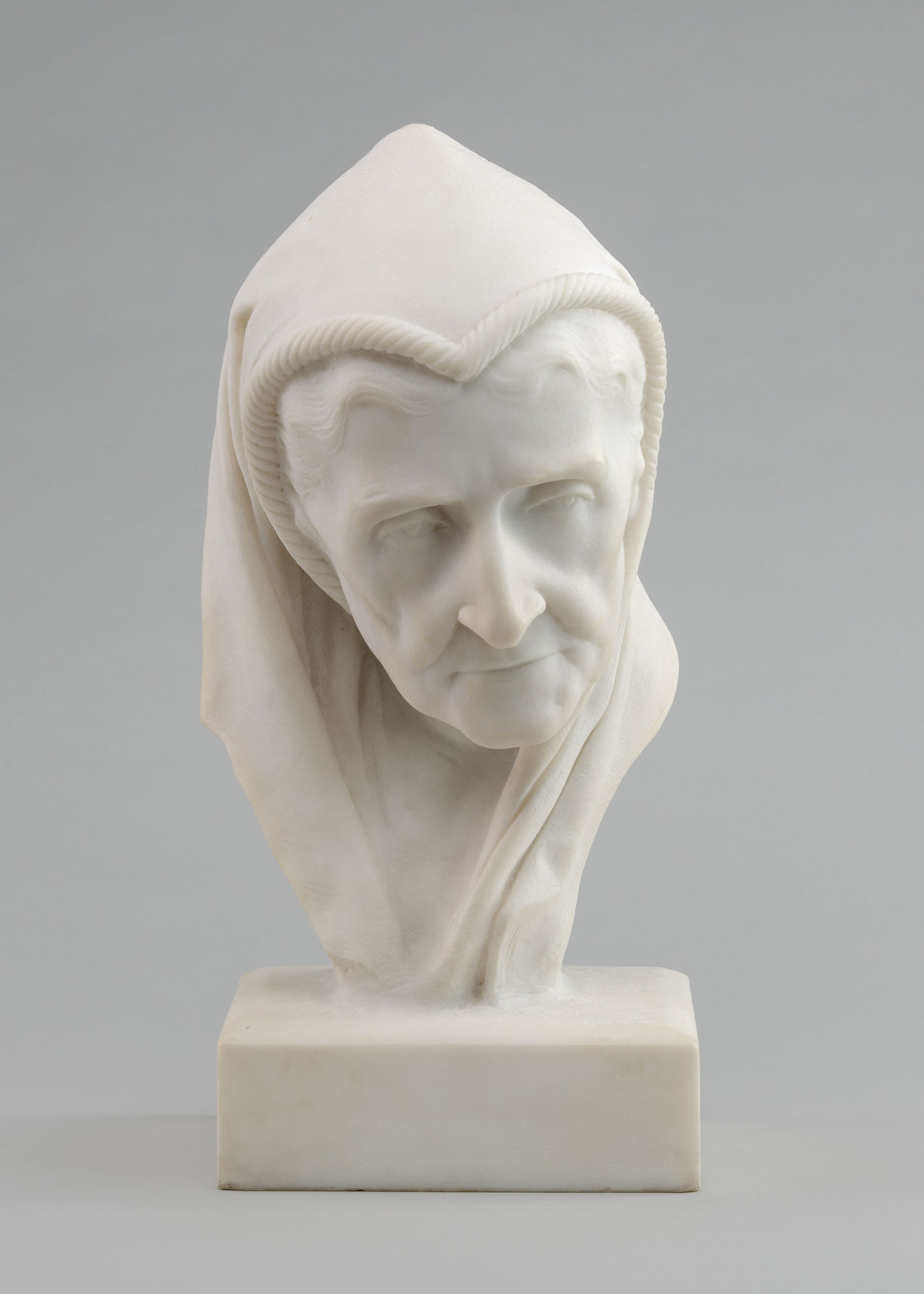
Anna Hyatt Huntington is best known for bronze statuettes of exotic animals. The New York Zoological Park (now the Bronx Zoo) provided the artist with set models and she challenged herself to capture the animals in motion, expressing their typical beliefs, gait, or posture. Creature sculptures became the mainstay of her career, and she sold numerous casts first to individual collectors and eventually to major museums. Her ambitions grew with her success and she won a commission from New York Metropolis for a awe-inspiring equestrian statue of Joan of Arc, a pop symbol of female strength, independence, and suffrage. (The memorial remains on view in Riverside Park today.)
Huntington occasionally turned to more personal projects, every bit represented by this sensitive and dignified marble bust of her mother, Audella Beebe Hyatt (1840–1932). Audella was also an artist and encouraged Anna's artistic talents. Sculptural busts of elder women are significantly less frequent than those of elder men.
Anna Hyatt Huntington,
half-dozen of xxx
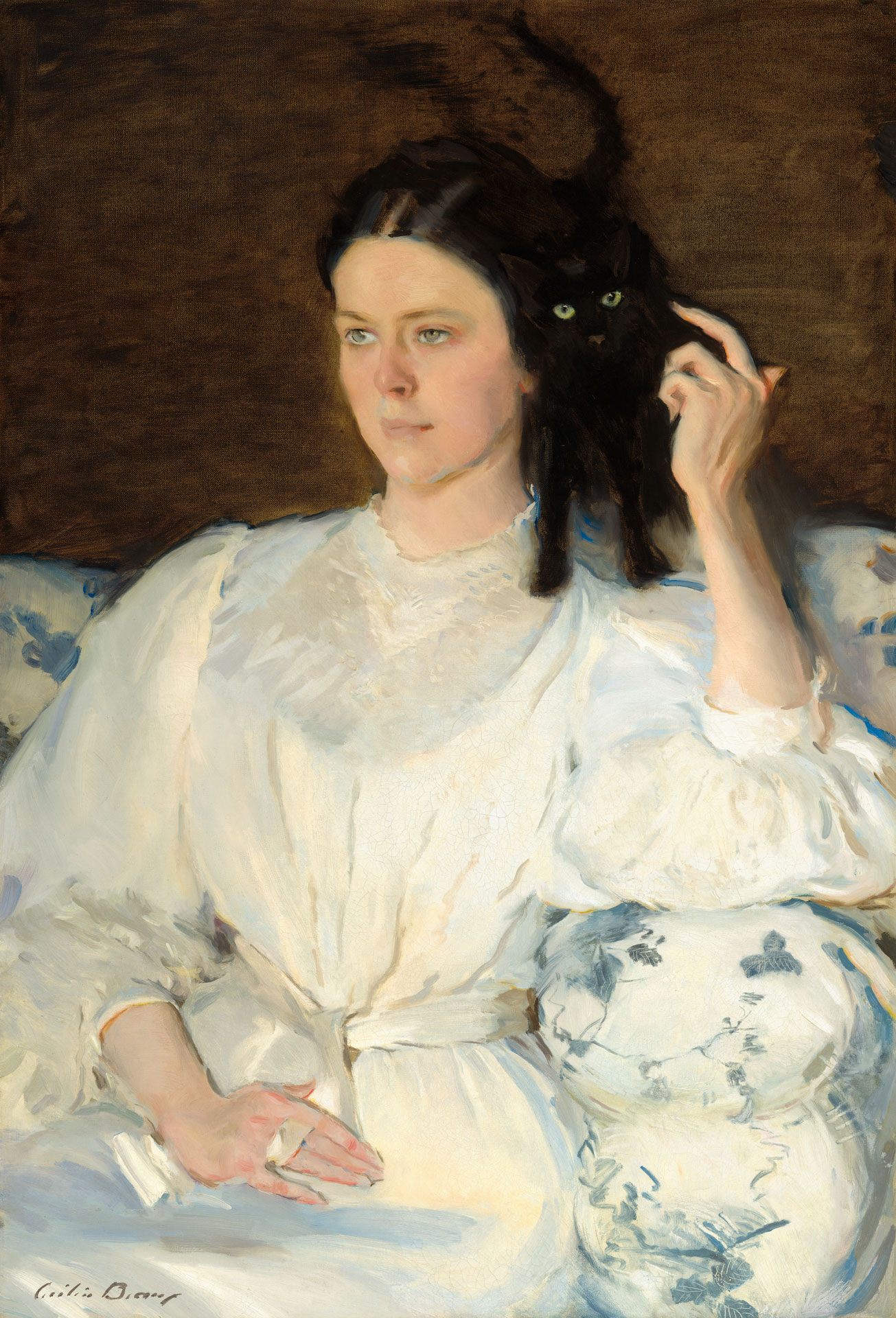
Cecilia Beaux pictures her cousin Sarah (identified with the Spanish derivation of her given name, Sarita) seated on a sofa with her feline companion, Sita (Castilian for "little one"), in a moment of placidity and reflection. Yous can imagine the cat'south slight weight on the woman's shoulder, soft fur brushing her ear, while she absently reaches up to scratch the true cat in turn. The understanding between the woman and her pet is underscored by the play of their names as well every bit their two sets of eyes in alignment: the cat looks out at u.s., while Sarita's gaze is distant. Pilus and fur pelt—glossy and dark—as well blend together. The portrayal of a relaxed and intimate moment at home suggests a level of trust between the two women, sitter and painter. Beaux was a successful contained portraitist, among the few self-supporting women artists of the early 20th century. She traveled to Europe to pursue artistic preparation, spending time in Espana equally well as France and England. What words would you use to depict the subject of this painting? Would you identify this work as an act of feminism? Why or why not?
Cecilia Beaux,
7 of thirty

Elizabeth Catlett created this commanding prototype of Harriet Tubman (built-in Araminta Ross, c. 1820–1913), the Underground Railroad conductor and abolitionist, pointing the way to liberty. Notice how the outsize figure of Tubman dominates the prototype, and how the assuming and energetic black lines of the print suggest the perilous, fraught conditions Tubman and those nether her protection navigated.
Catlett, who was the granddaughter of people who were enslaved, often focused on issues of Black and women'south history in her art. Her artistic influences included the social activism of Mexican muralists Diego Rivera and José Clemente Orozco, which she learned well-nigh as a student at Howard Academy in Washington, DC. Another teacher, the American painter Grant Wood, encouraged her to draw upon what she knew all-time. "Of course, it was my own people," she noted.
At the fourth dimension Catlett made this work, the civil rights movement was gaining ground in the United States. Why might Catlett accept chosen to depict Harriet Tubman? What do Catlett'southward artistic choices reveal about her perception of Tubman?
Elizabeth Catlett,
8 of 30
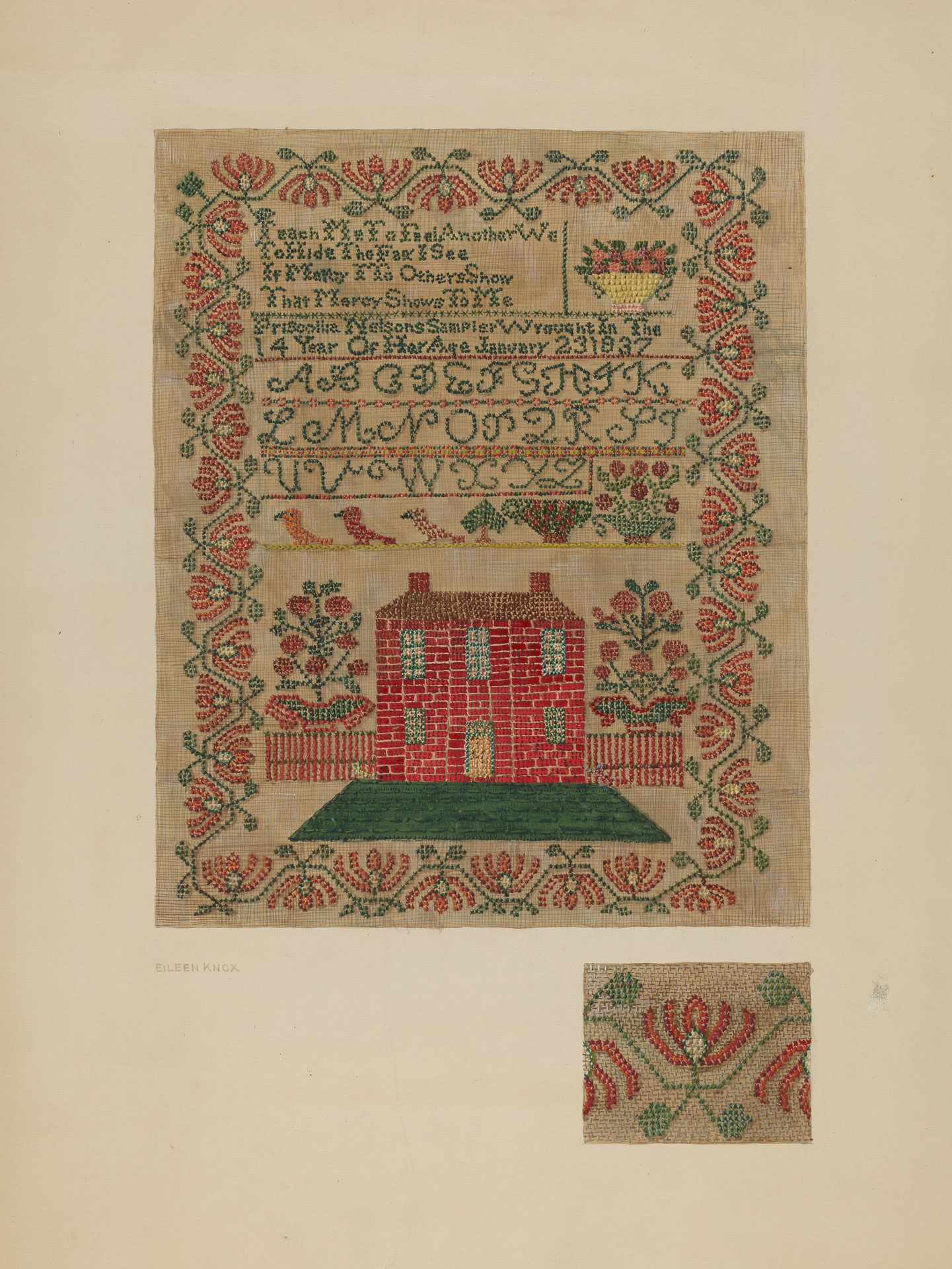
This drawing depicts an case of needlework from the belatedly 19th century. Young women fabricated samplers to practice needle arts and to demonstrate different embroidery stitches. If you overstate the drawing (which is colored with gouache paint), you will see that it is so fine and realistic that information technology almost appears to be a photo. The sampler includes a brick house, likely the 14-twelvemonth-old maker's home, and a quote from 18th-century English poet Alexander Pope (with some incomplete messages): "Teach me to feel another's woe / To hide the error I see / In mercy I to Others show / That Mercy shows to me."
This work is office of the Index of American Design (IAD), a body of 18,000 drawings that chronicle the history of American decorative art, folk art, and craft objects from the 17th century until nearly the turn of the 20th century. The IAD was a project of the Works Progress Administration (WPA), created during the Depression to provide employment to out-of-work people, including artists. There was a college proportion of women working in the IAD project than in other federal art programs at the fourth dimension, perhaps indicating greater opportunity for women illustrators. These jobs were a small portion of the total WPA jobs created, the dandy majority of which were available in construction, edifice roads and infrastructure, and largely reserved for men.
Are there whatever activities in your own life that are viewed every bit belonging to a specific gender? How do you feel about this perception? If women artists were to continue to add work to the IAD today, how might the subject affair compare to these works of art?
Eileen Knox,
ix of 30
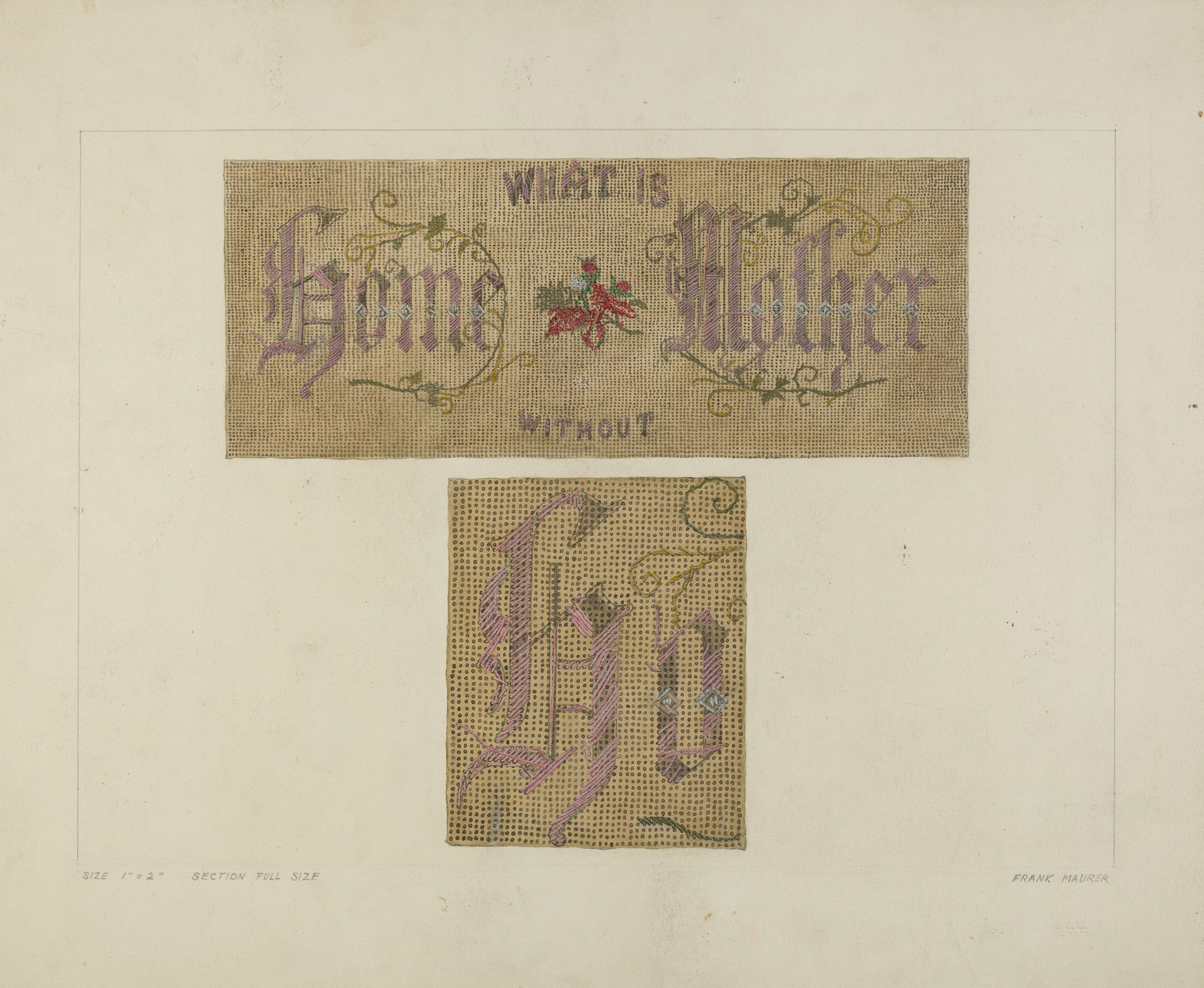
This drawing depicts an case of needlework from the late 19th century. Young women made samplers to practice needle arts and to demonstrate different embroidery stitches. If you lot enlarge the cartoon, you volition see that it is and then fine and realistic that it almost appears to be a photograph. The sampler offers the sentiment "What is home without Mother," signaling traditional ideas of the mother equally the heart of the abode and of domestic life in full general.
This work is part of the Alphabetize of American Design (IAD), a torso of eighteen,000 drawings that relate the history of American decorative fine art, folk art, and craft objects from the 17th century until well-nigh the turn of the 20th century. The IAD was a project of the Works Progress Administration (WPA), created during the Depression to provide employment to out-of-work people, including artists. There was a higher proportion of women working in the IAD project than in other federal art programs at the time, perhaps indicating greater opportunity for women illustrators. These jobs were a small portion of the total WPA jobs created, the great bulk of which were available in construction, building roads and infrastructure, and largely reserved for men.
Are there any activities in your ain life that are viewed as belonging to a specific gender? How practice y'all feel about this perception? If women artists were to continue to add piece of work to the IAD today, how might the discipline matter compare to these works of art?
Frank Maurer (artist), Thomaszine Downing Woodward (object maker),
10 of xxx
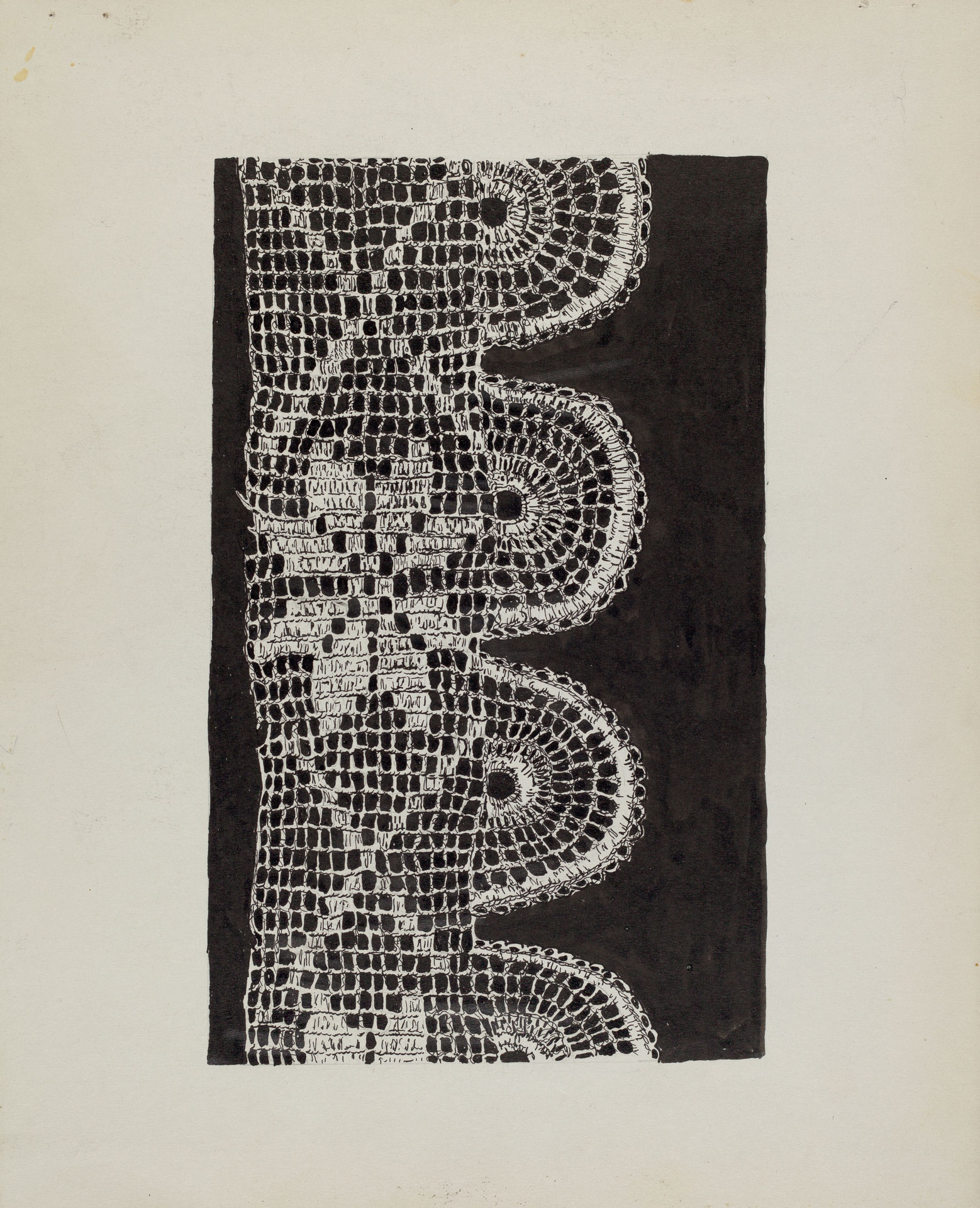
This cartoon depicts an instance of needlework from the belatedly 19th century. Immature women crocheted items that could decorate clothing, tablecloths, and curtains. If you enlarge the cartoon, you will see that it is so fine and realistic that it almost appears to be a photograph.
This work is office of the Index of American Design (IAD), a trunk of 18,000 drawings that chronicle the history of American decorative art, folk fine art, and arts and crafts objects from the 17th century until well-nigh the turn of the 20th century. The IAD was a project of the Works Progress Administration (WPA), created during the Depression to provide employment to out-of-piece of work people, including artists. At that place was a higher proportion of women working in the IAD project than in other federal art programs at the time, maybe indicating greater opportunity for women illustrators. These jobs were a small portion of the total WPA jobs created, the neat bulk of which were available in construction, building roads and infrastructure, and largely reserved for men.
Are at that place whatever activities in your own life that are viewed every bit belonging to a specific gender? How practise you feel about this perception? If women artists were to continue to add work to the IAD today, how might the subject matter compare to these works of art?
Lena Nastasi (artist), Laura McCall (object maker),
11 of 30
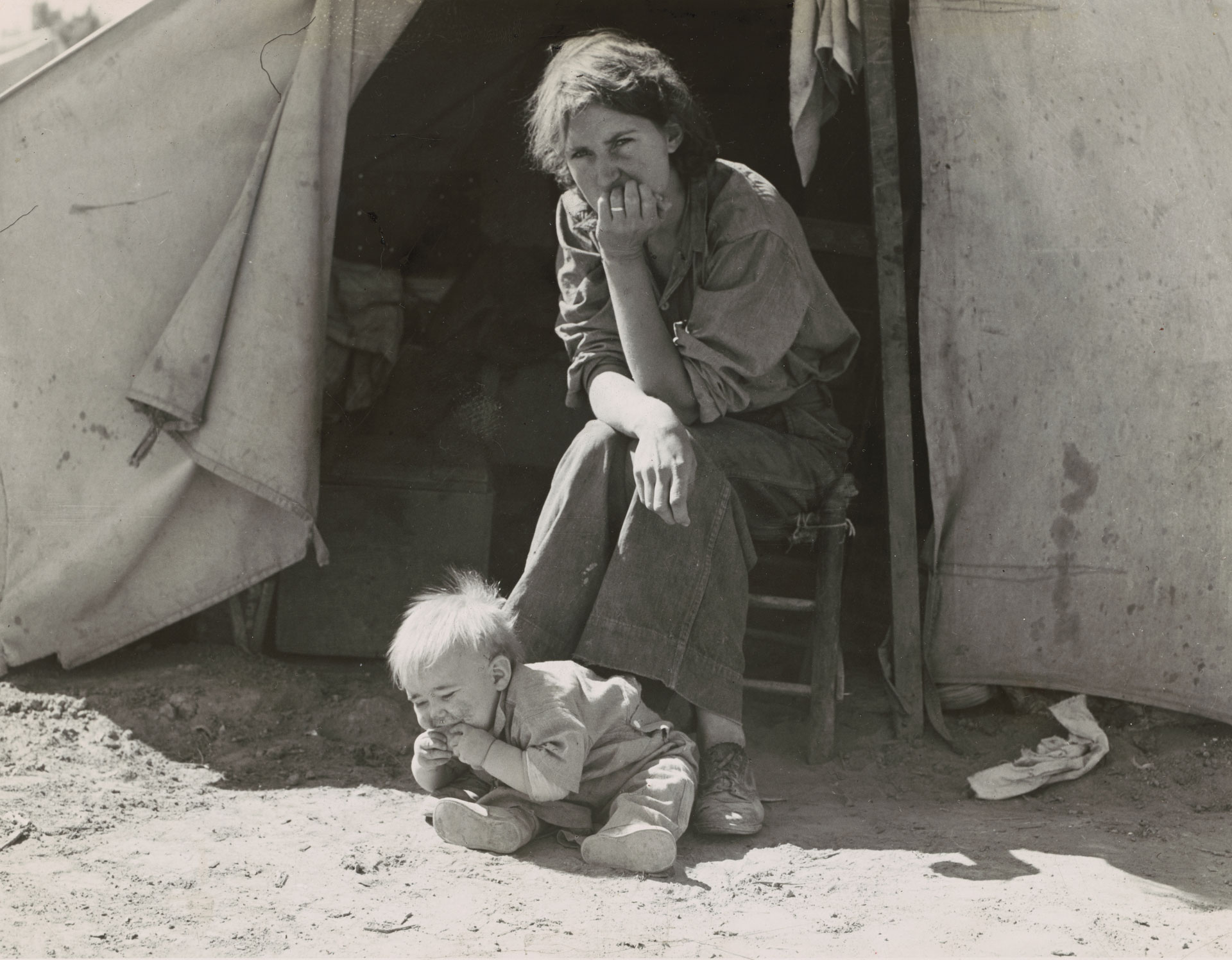
Dorothea Lange's photographs of people impacted by the Depression are her nearly well-known work. She wanted to prove the public and politicians the reality and depth of the United States' social and economic problems. Working for the Subcontract Security Assistants, an agency created by President Franklin Delano Roosevelt to accost the plight of farmers afflicted by the dust bowl, Lange fabricated many photographs of migrants who traveled to California during the 1930s seeking agricultural piece of work. Yet piece of work was scarce, and often migrants ended up unemployed in encampments, some ready as public relief programs. Hither a young mother sits in front of her government-issued tent with her child at her anxiety. Her expression communicates a toughness and a kind of resignation. Lange sometimes shared her photographs with newspapers in order to draw the public's attending to people'south suffering. On one occasion, the publication of her photographs in the San Francisco News resulted in an outpouring of 20,000 pounds of food donations for malnourished migrant workers.
Consider how the female person experience might differ across socioeconomic course, race, and fourth dimension. How does this prototype compare to some other 1937 photo by Lange of a Japanese mother and daughter serving equally agricultural workers?
12 of xxx
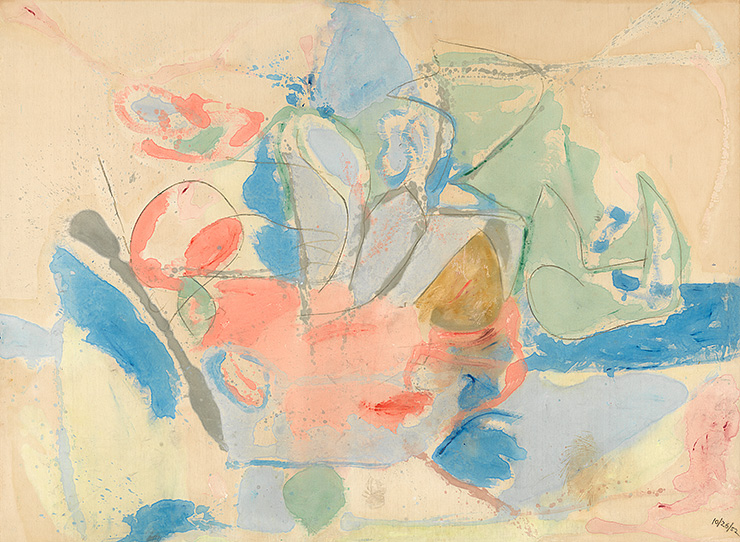
At age 23, Helen Frankenthaler painted Mountains and Sea, a breakthrough work that has influenced generations of artists. Using thinned oils, she poured the paint in pools that flowed across the surface of her raw (or unprimed) canvas, which was placed on the floor. This process created luminous fields of transparent color, while some areas, mostly around the edges, were purposely left open and immune the weave of the raw canvas to flatten the paradigm. This "soak/stain" technique, which Frankenthaler pioneered, proved an important step forrard for painting.
The title of this painting was inspired past a summertime trip to Cape Breton Island in Nova Scotia, Canada, where Frankenthaler encountered a view of the land and ocean meeting in a disharmonism of waves, rocky shore, and brilliant light. This work was shown in a gallery exhibition in 1953 in which non a single painting was sold. Frankenthaler would proceed to go one of the most celebrated artists of her time.
Are there pioneering women who inspire you?
Helen Frankenthaler, Mountains and Sea, 1952, oil and charcoal on canvas, Helen Frankenthaler Foundation, Inc., on loan to the National Gallery of Art, Washington
13 of 30
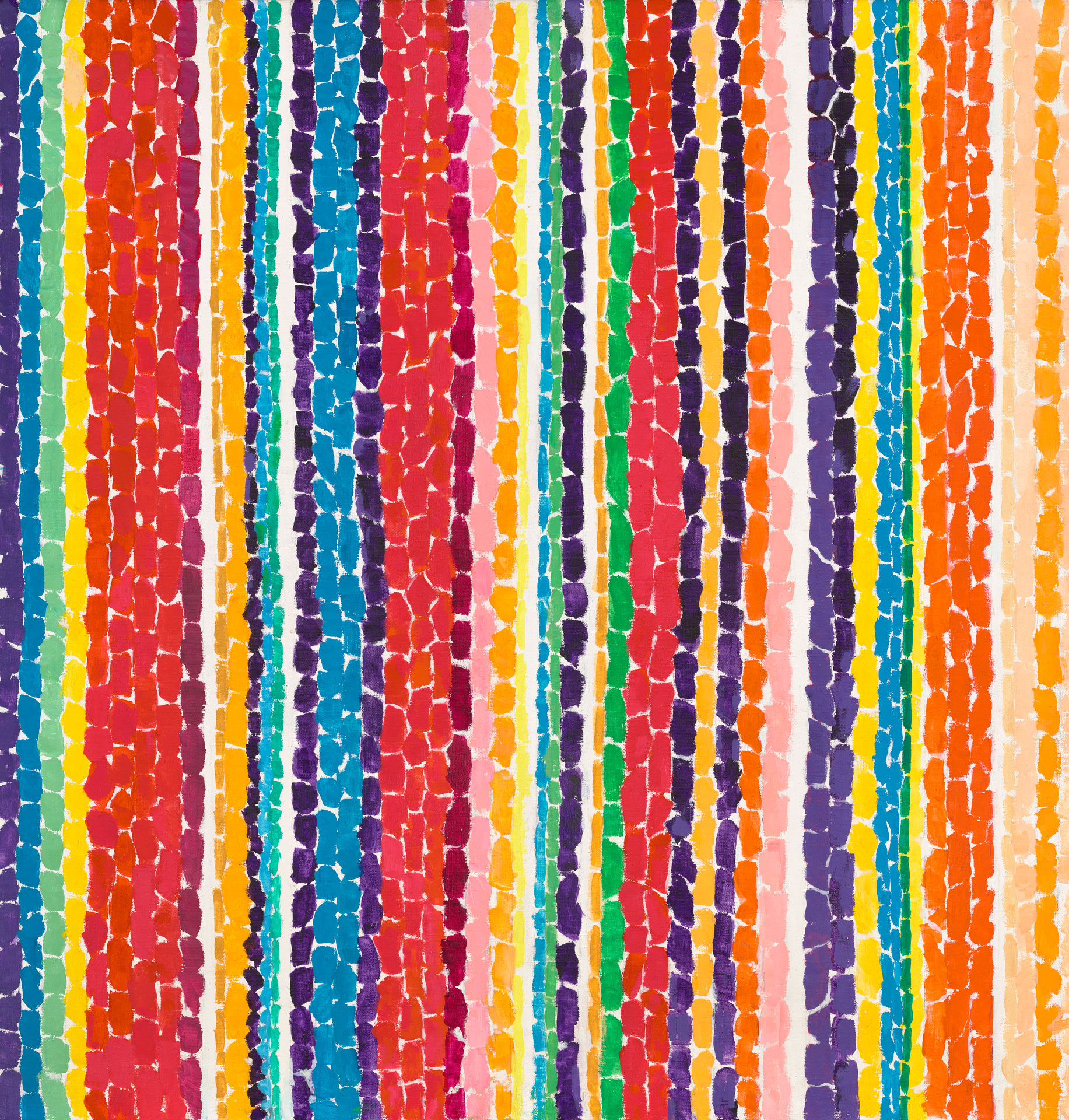
The part of color is of "paramount importance." As Alma Thomas said, "through color I have sought to concentrate on dazzler and happiness in my painting rather than on man's inhumanity to man." Thomas created this work when she was well into her seventies. The creative person plant inspiration in landscapes and flowers around her, which she stylized in shapes and patterns created with repeated, colorful brushstrokes. Her paintings are infused with personal memories and references; in this case, the work's title refers non only to the springtime flowers that populate Washington, DC, where she lived, but also to the plucky song published in 1929 and famously recorded by Tiny Tim in 1968.
Although Thomas worked as an artist steadily her entire life, setting upward a studio in her home, she was unable to make a living every bit an artist. As an African American woman who grew upwardly in the South during the Jim Crow era, she experienced the boosted weight of racism and segregation. Thomas chose one of the few options available to women who sought employment and financial independence: a degree in didactics, which she applied to a career of over 40 years didactics in Washington, DC, public schools, all the while painting during nights and on weekends. Upon retirement at age 69, she devoted herself full-time to art making. She realized a remarkable and productive "second act" in life, achieving visibility and, at age lxxx, a solo museum exhibition (at the Whitney Museum of American Art in New York).
Consider your own community: Who are the artists around you? What can you discover in your ain environment that inspires you? Can you identify a text or song that shares the mood of this work of art?
Alma Thomas,
xiv of 30
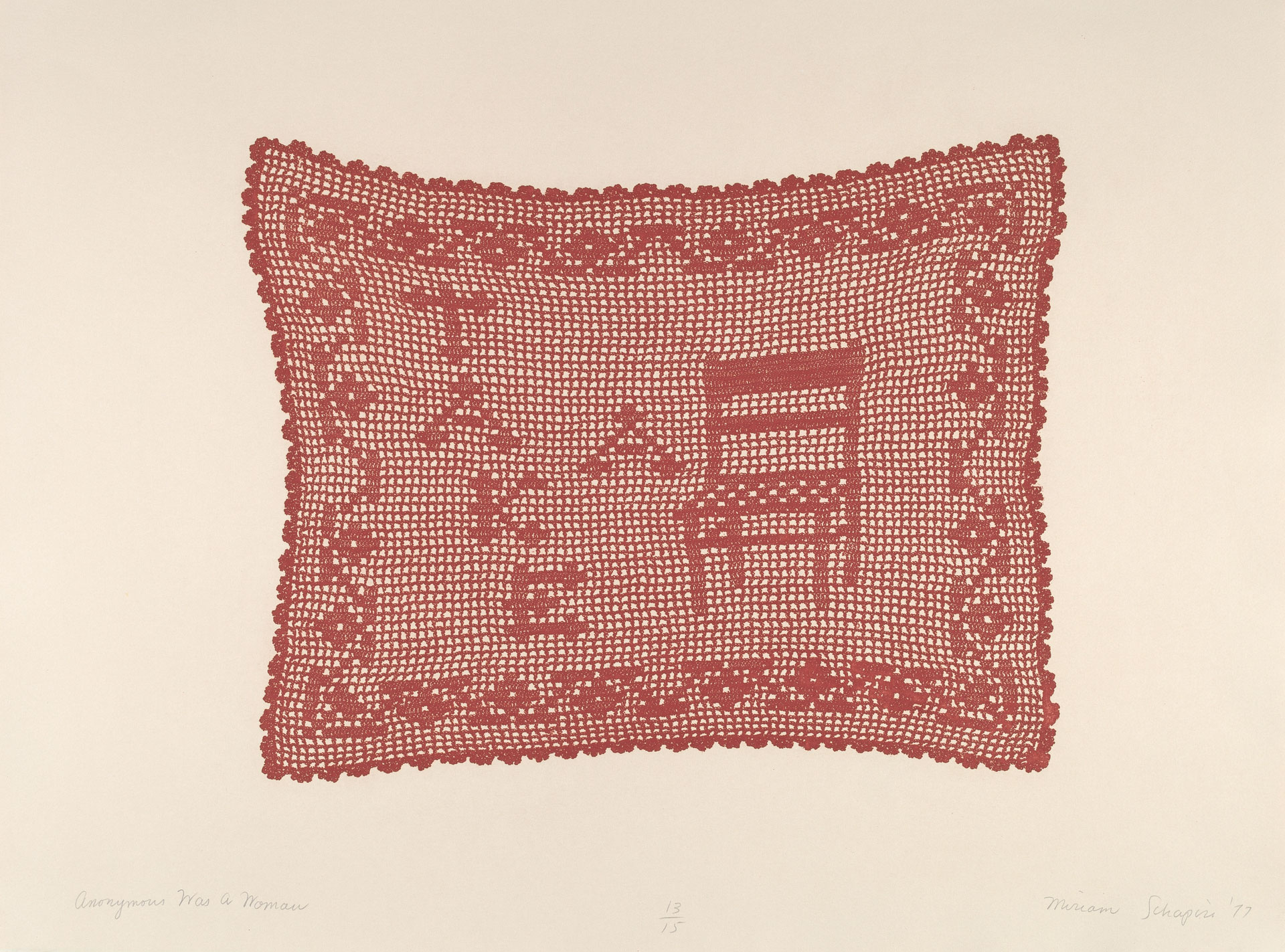
Miriam Schapiro was a pioneer of feminist art starting time in the 1970s. Feminist art gave visibility and voice to the particular conditions of women's personal and socioeconomic lives. Schapiro's etchings of crochet call back drawings of similar objects from the Alphabetize of American Blueprint (IAD). Traditional, embroidered samplers and examples of fine crochet made by generations of young women—and visually documented in the IAD—embody conventional expressions of domesticity. Schapiro's works slyly subvert those ideals while also paying homage to household labor and activities performed largely past women. This carving commands "Take a Seat," with an epitome of a chair replacing the concluding give-and-take. It was role of a series that recognized the unseen and uncredited work of women in the dwelling house, whether sewing, mending, cooking, or cleaning.
Miriam Schapiro,
15 of 30
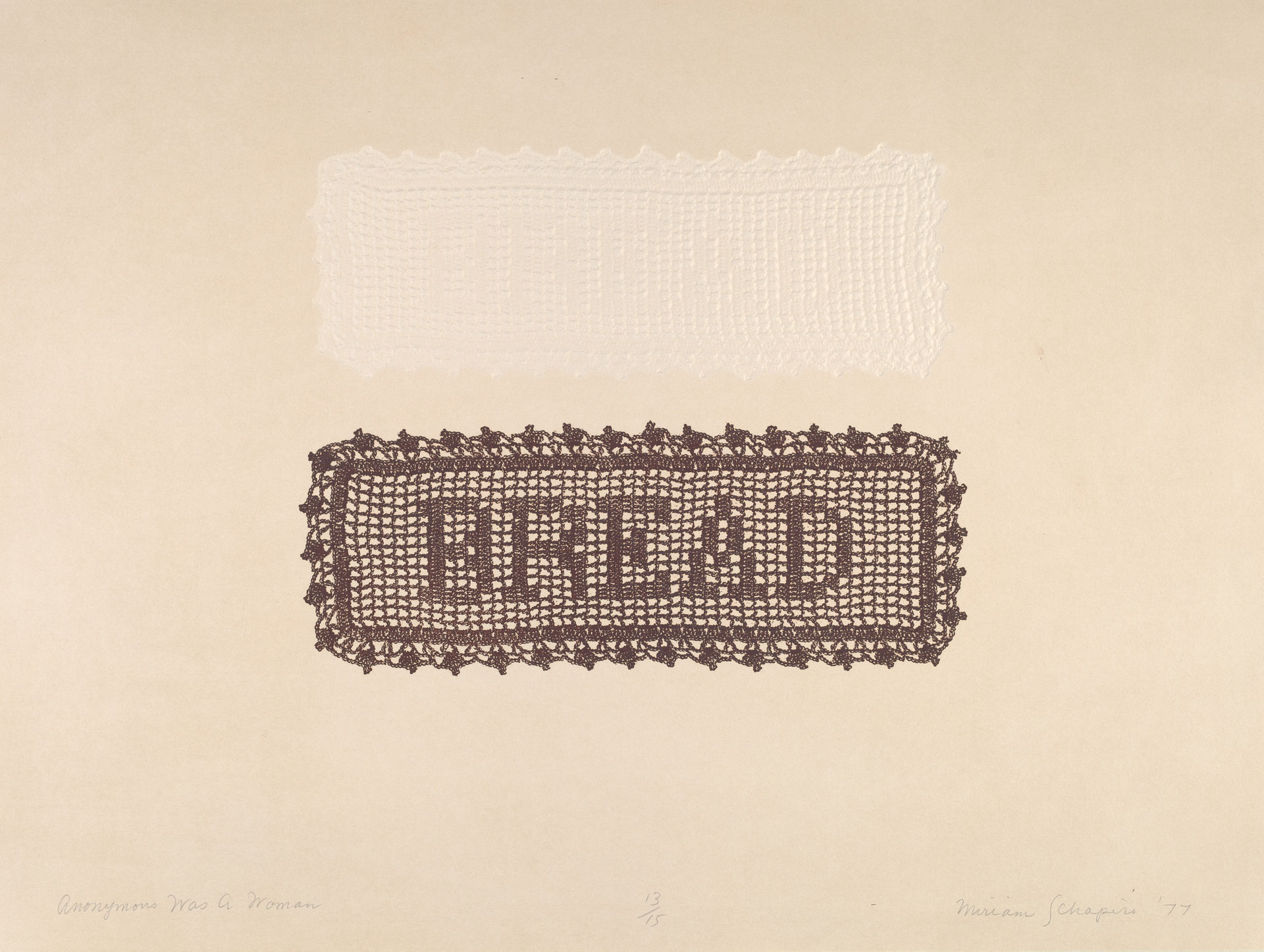
Miriam Schapiro was a pioneer of feminist art starting time in the 1970s. Feminist art gave visibility and vocalisation to the particular conditions of women's personal and socioeconomic lives. Schapiro'due south etchings of crochet recall drawings of similar objects from the Alphabetize of American Design (IAD). Traditional, embroidered samplers and examples of fine crochet fabricated past generations of immature women—and visually documented in the IAD—embody conventional expressions of domesticity. Schapiro'southward works slyly subvert those ideals while too paying homage to household labor and activities performed largely by women. This carving looks similar a bread doily through which some flour has left a respective grid. (The duplicate white image was created by putting the same plate, uninked, through the printing press.) The shape of the sampler too suggests a dollar bill—perhaps a pun on the discussion "bread," likewise as the idea that this was the but kind of "bread" women could make at certain points in history. This etching was part of a series that recognized the unseen and uncredited work of women in the home, whether sewing, mending, cooking, or cleaning.
Miriam Schapiro,
16 of 30
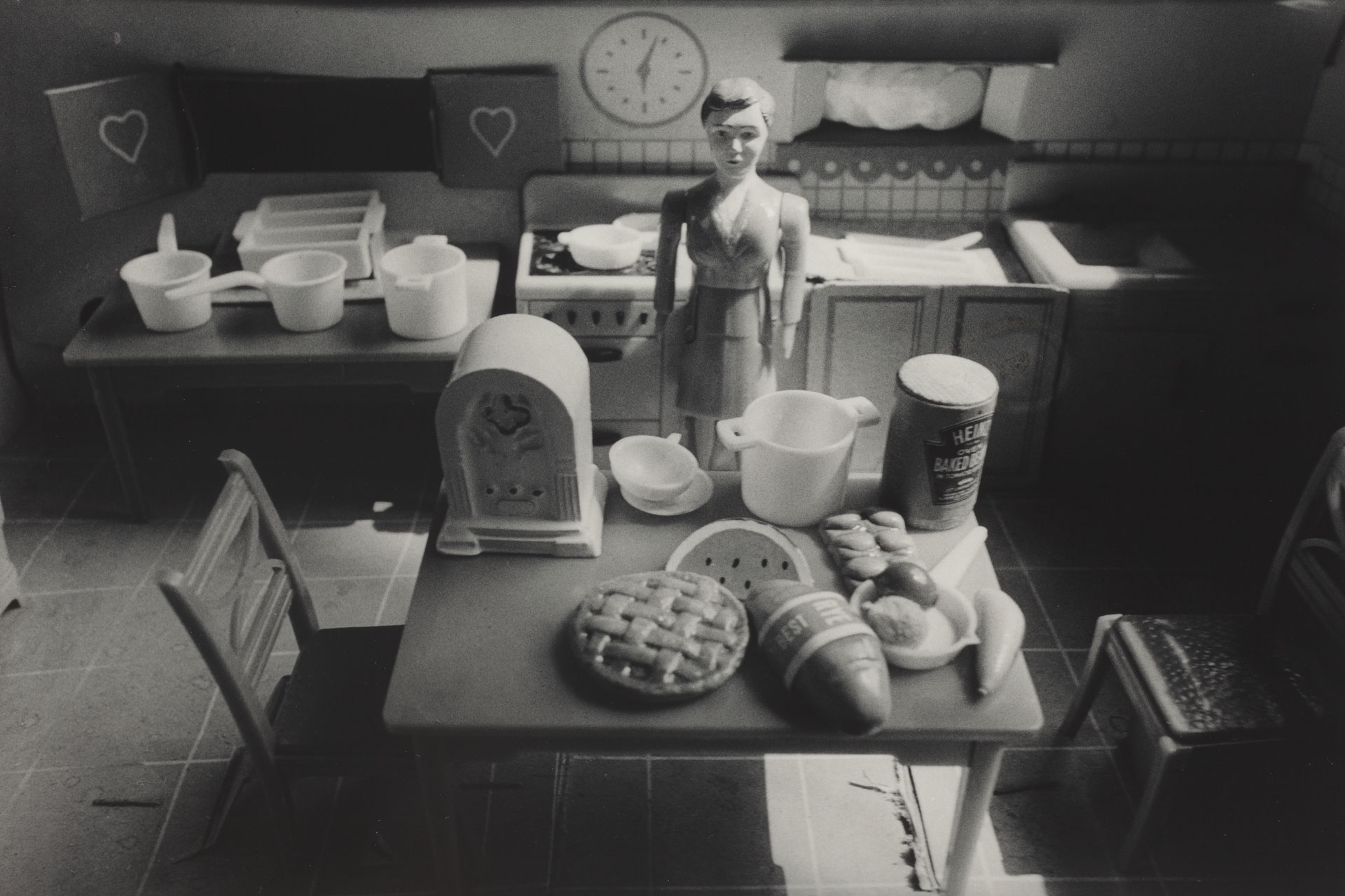
Laurie Simmons creates fictional tableaux which she carefully lights and photographs. Some are miniature scenes, such every bit this ane of a woman/doll in a kitchen. While the motion picture looks like it could be a peek into a dollhouse, the style in which Simmons presents the scene suggests something off-kilter and discomfiting. The blackness-and-white photograph and its dramatic lighting evoke former Hollywood films of the mid-twentieth century. During that fourth dimension, pop culture—including movies and toys—often reinforced gender stereotypes, depicting women in domestic roles. In Adult female/Imperial Clothes/Kitchen, a clock shows the time as just afterwards six o'clock: Is information technology early evening and the woman/doll awaits the arrival of her spouse? As is often the case with dollhouses, the proportions of the objects are slightly off. Here an array of baked goods, kitchen utensils, and a behemothic radio on the table are one-half as large as the woman/doll standing behind them.
Consider how you observe, internalize, and claiming gender roles in your life. Exercise you see any evidence of irresolute viewpoints in society? What are they?
Laurie Simmons,
17 of 30
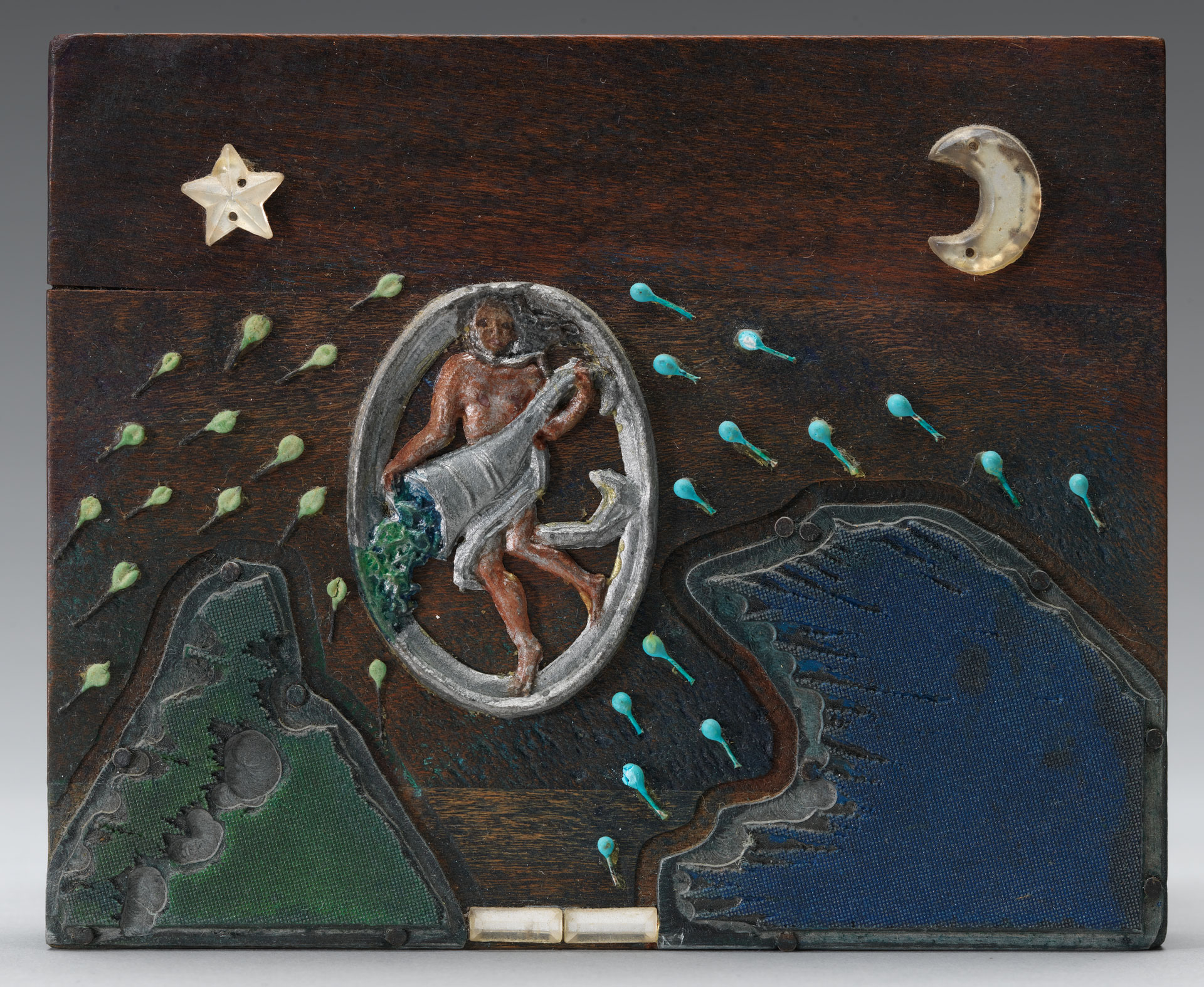
Betye Saar is a Los Angeles–based artist who mingles personal history, mythology, and folk art to reverberate upon her life and the African American feel. Twilight Awakening centers on a powerful primal figure who hovers betwixt the space of body of water and land, the moon and star. The piece of work's symbology indicates that the figure is Aquarius, the Water Bearer. The signs of the zodiac derive from Roman antiquity, visualizing the passage of time through labor and activities associated with dissimilar times of the year. The work is a iii-dimensional assemblage: it is made on a wooden base of a recycled printer's block, to which Saar added scavenged and sculpted pieces of plastic, ceramic, and drinking glass. These personal objects, bearing marks of use and history, lend a magical power to the tiny panel measuring only 3 ¾ × 4 ½ × ¾ inches. Who are the storytellers in your life? How exercise they share their stories?
Betye Saar,
18 of 30
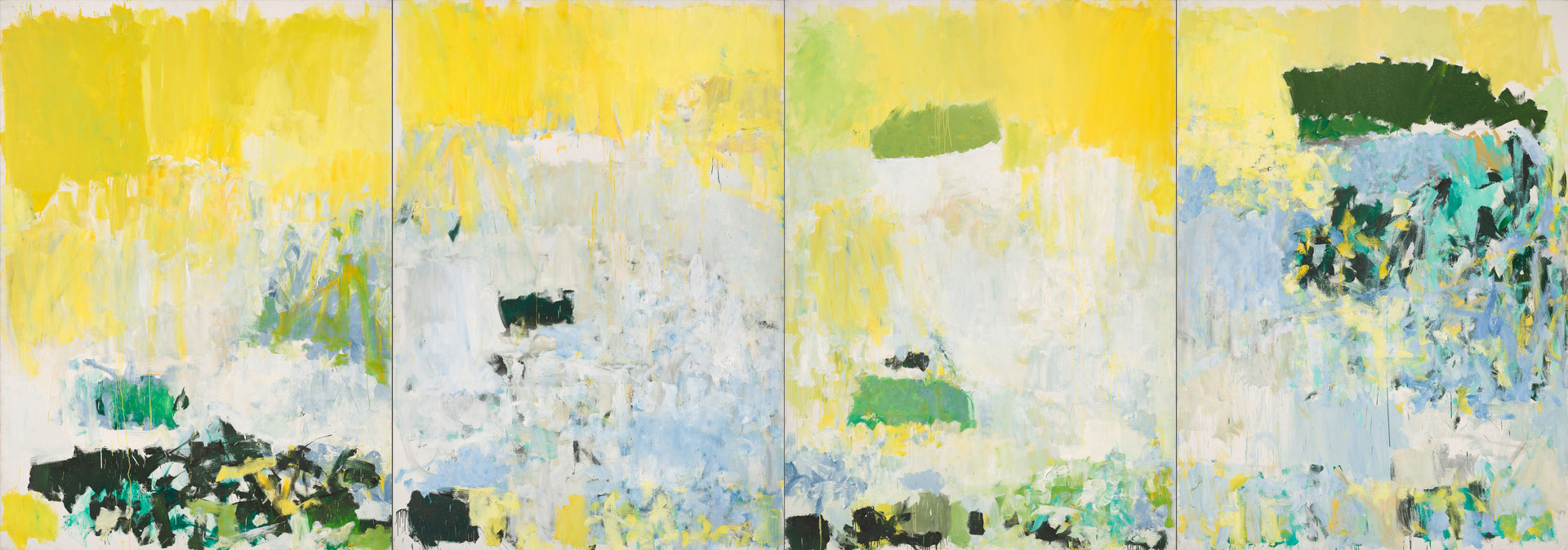
This flick consists of four panels that are 26 feet long altogether. The painting's grand horizontal calibration with its brilliant lemon-yellowish background, white plumes in the heart basis, and green and blue textures suggest immersion in a sunny summer landscape, radiating light, open air, and nature. Mitchell said, "My paintings…aren't most fine art issues. They're near a feeling that comes to me from the outside, from landscape." In what ways is it possible to visually portray intangible things similar a feeling?
Do you think gender identity must be addressed or made visible in a woman'south work of fine art? What are the limitations that take been placed on women in all fields, historically and at present?
Joan Mitchell,
xix of 30

In this prototype, a girl is dressed formally for her fiesta de quince años, or quinceañera, to mark her entry into womanhood. This special recognition of the 15th birthday is a custom in Mexican and other Latin American cultures. Graciela Iturbide contrasts this celebration of emerging adulthood with the presence of the girl's grandmother seated in the foreground, whose advent suggests a life of hardship. The expressions of the two relatives are distant and difficult to read.
Iturbide is amidst the foremost figures in Mexican photography, known for her work documenting Ethnic cultures effectually the globe. In 1978 the Instituto Nacional Indigenista hired her to photo Mexico's Indigenous populations. Every bit part of that work, she traveled to Juchitán, whose inhabitants are of Zapotec heritage, with a matriarchal society. This photograph is from that project, collectively published as Juchitán de las Mujeres (1989).
Graciela Iturbide,
20 of xxx
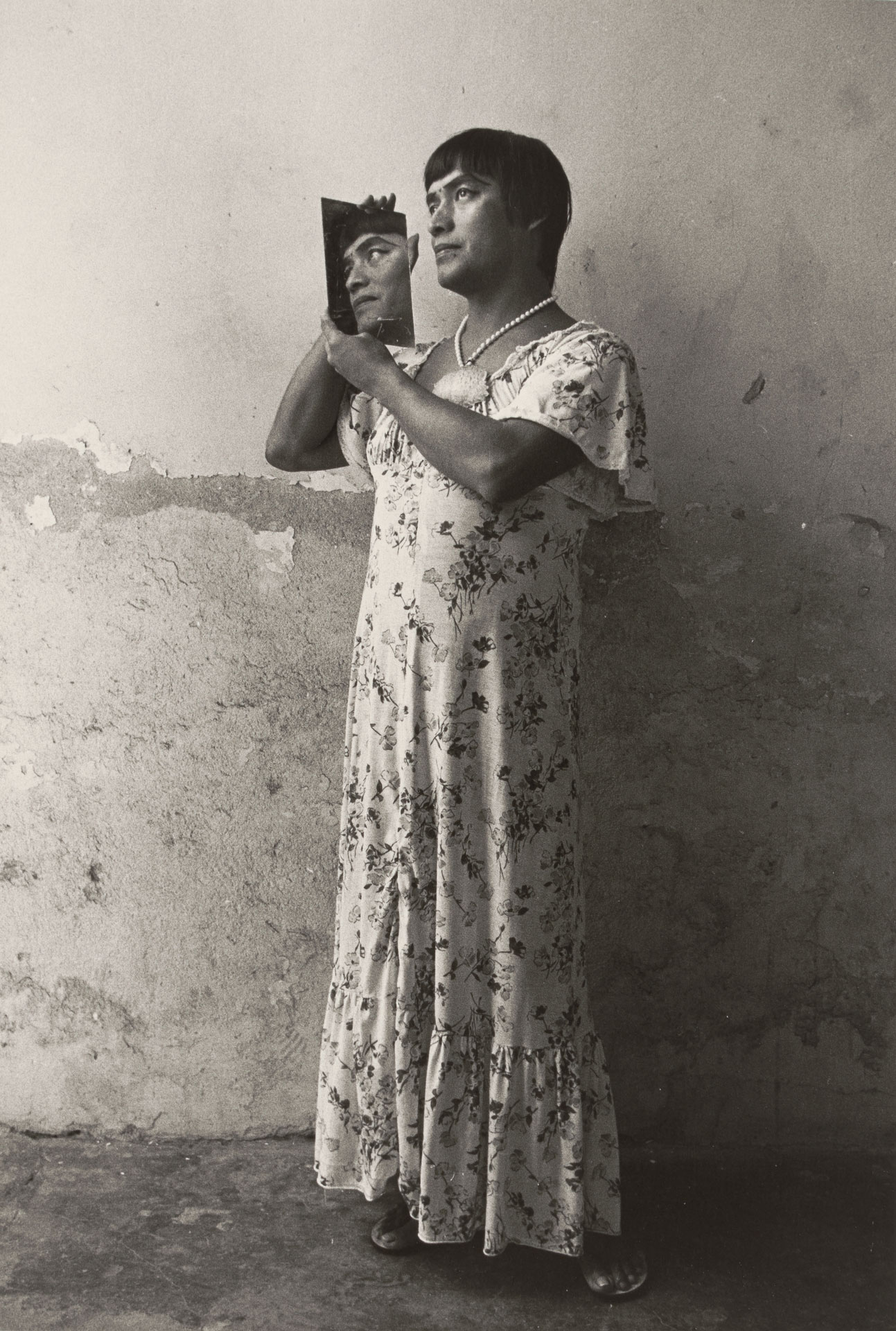
Graciela Iturbide is amid the foremost figures in Mexican photography, known for her work documenting Ethnic cultures around the world. In 1978 the Instituto Nacional Indigenista hired her to photo United mexican states's Indigenous populations. As function of that work, she traveled to Juchitán, whose inhabitants are of Zapotec heritage, with a matriarchal society. This photograph is from that project, collectively published as Juchitán de las Mujeres (1989).
Iturbide'southward practise involves immersing herself into the communities that she photographs. While shopping for groceries one day, she was approached past Magnolia, who wanted her picture taken. Magnolia was part of a community of muxes, individuals assigned male person at birth just who identify as other genders. In some Indigenous cultures, muxes are considered a third gender and people with special powers. Magnolia holds a mirror up to her profile, doubling her epitome and suggesting the multiple ways that identity may be presented.
Graciela Iturbide,
21 of 30
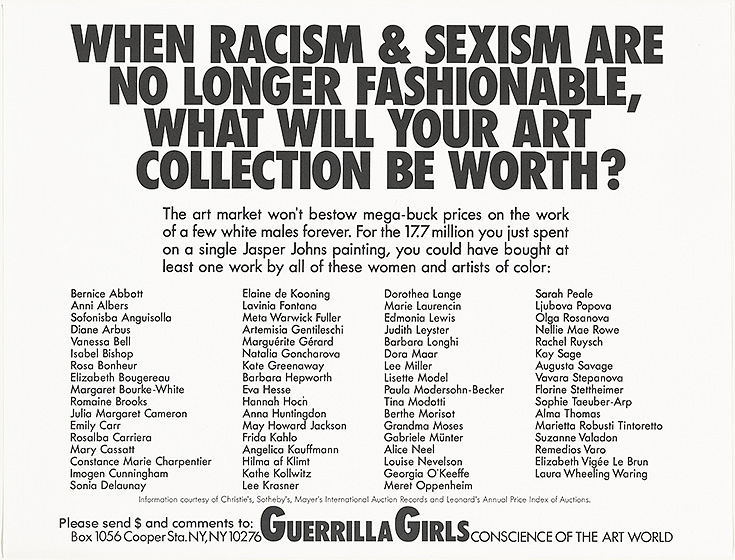
The Guerrilla Girls is an anonymous and ever-changing group of women artists, curators, and writers who apply performances, public demonstrations, and visual art to advocate for greater representation of diverse artists in museums, galleries, fine art publications, and other creative pursuits. The Guerrilla Girls dress in full-body gorilla suits to perform guerrilla actions, such as protests, on behalf of women and other underrepresented groups in the art world. The costumes disguise their existent identities and allow them to assume the pseudo-identities of famous women artists. This satirical gesture familiarizes women artists' names while likewise preventing the individuals from being blackballed by the institutions against which they protest.
This lithograph is considered a fine fine art object, all the same the paradigm/text has been produced in different formats and materials to function as a protestation affiche, like to what you might see in a demonstration or plastered on double-decker cease shelters or walls. The Guerrilla Girls collect information and statistics upon which they base of operations their clever and boldly headlined messages nearly fine art world inequities. To appointment, approximately 11 percent of the artists represented in the National Gallery of Art collection are women.
Do you discover this an effective form of activism to address sexism? Why or why not? What other methods have activists used today and in the recent past to address sexism?
22 of xxx
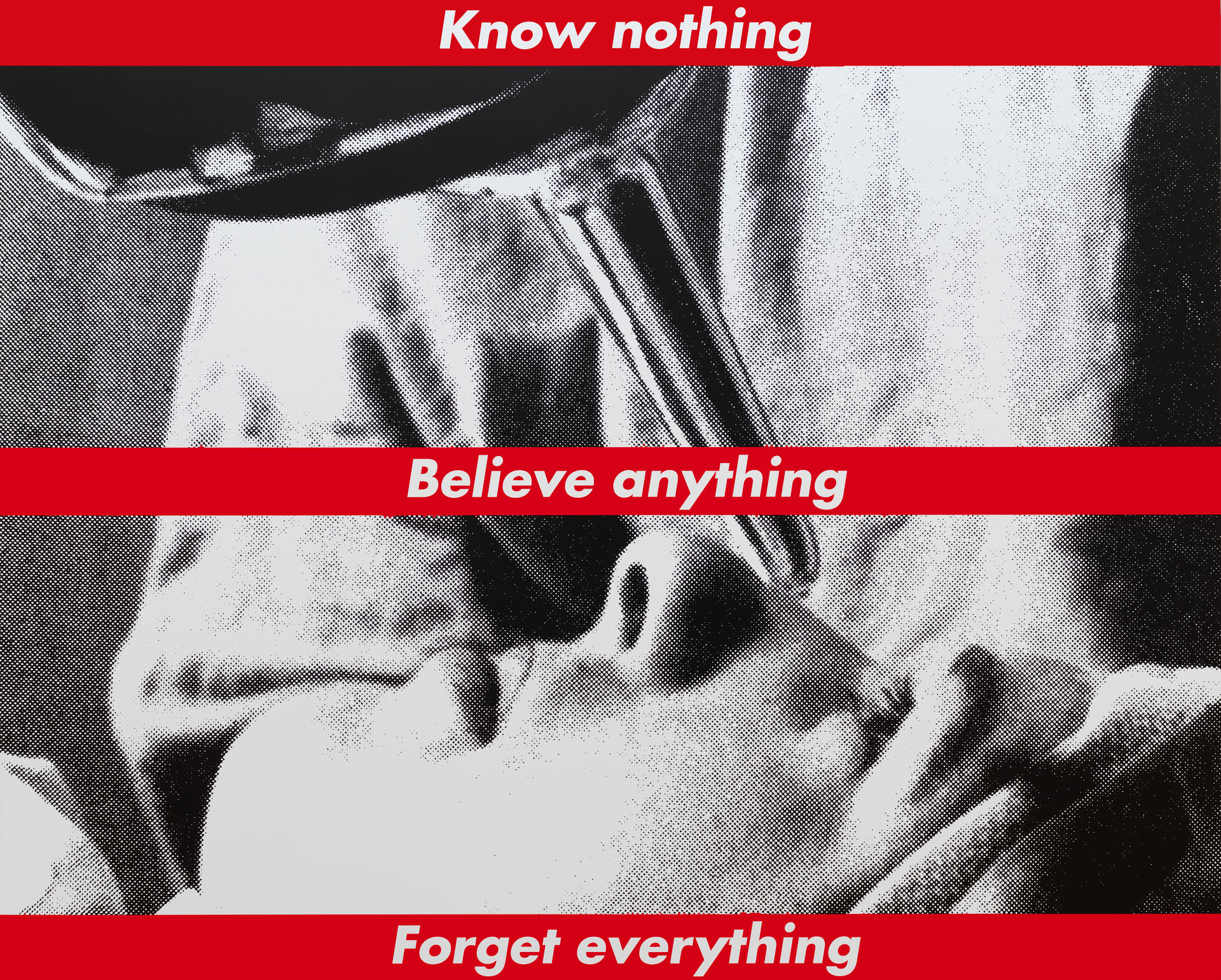
Barbara Kruger got her beginning working as a graphic designer at Glamour mag in the late 1960s. Before digital folio layout existed, graphic designers made "paste-ups" comprising collaged elements—such equally titles, texts, captions, and images—to create a designed page. The collage was then photographed for reproduction in the magazine. Kruger has riffed on this process in her work as a visual artist. Using a distinctive graphic way, she exposes power dynamics in her personal life, piece of work, and politics. This image depicts a woman receiving a mysterious treatment to her centre administered past the faceless figure of a medical professional in the background. The 3 red bars with text carve up the medical musical instrument in the height half from the receptive, passive woman in the bottom half with the ominous text: "Know nada / Believe anything / Forget everything." What might those words imply?
Why do you think the artist uses text aslope her image? How does the text chronicle to the image that it is paired with? How can fine art be a vehicle for social critique?
Barbara Kruger,
23 of xxx
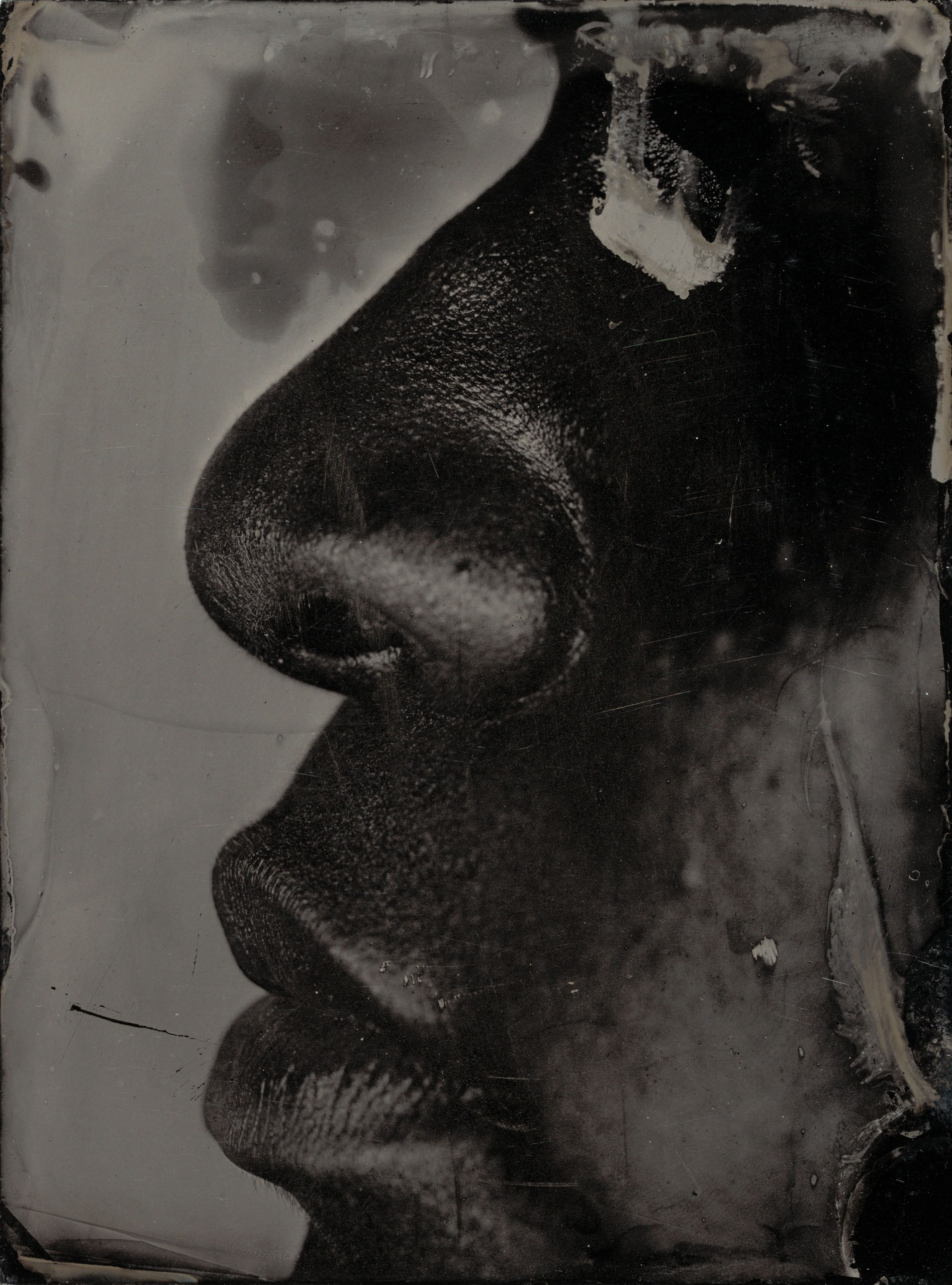
This close-up self-portrait by Myra Greene addresses the complexity of how we see other people and what nosotros can know by seeing them. The photograph isolates and fragments a office of Greene's face, denying us the power to meet her as a whole. The work intentionally uses a vintage photography technique chosen ambrotype to allude to a 19th-century version of racial profiling in which photography was used to classify facial features to back up white supremacy. This photograph is function of a series titled Character Recognition. Greene began this projection in 2006, noting, "Confronted with an upwardly swell of bigotry both personal and public, I was forced to ask myself, what practise people see when they look at me. Am I nil but blackness? Is that skin tone plenty to describe my nature and expectation in life?"
Could this work be considered an human activity of intersectional feminism? Why or why non?
Myra Greene,
24 of 30
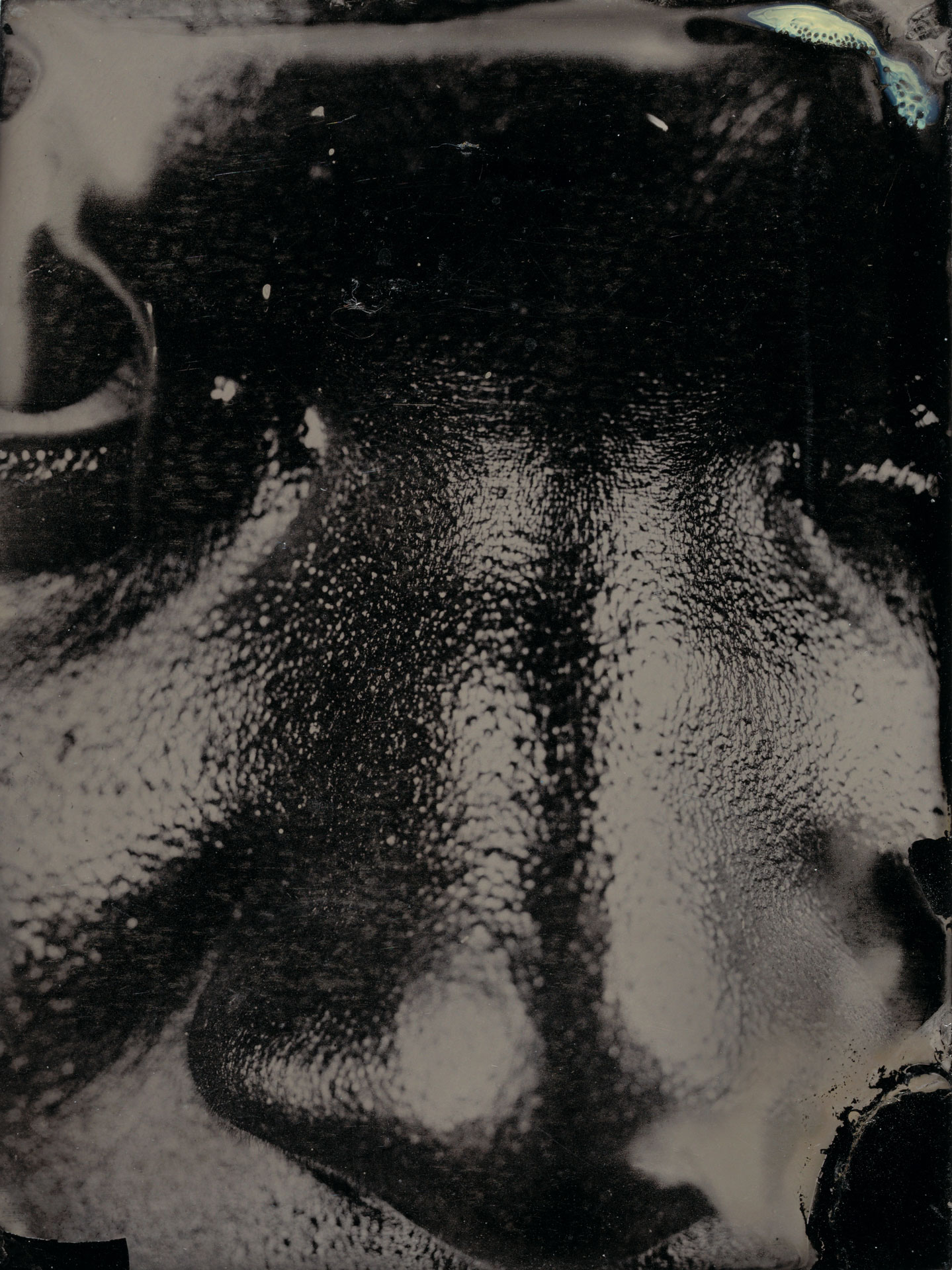
This shut-up self-portrait by Myra Greene addresses the complication of how we see other people and what nosotros tin can know by seeing them. The photo isolates and fragments a office of Greene'southward face, denying usa the power to meet her as a whole. The work intentionally uses a vintage photography technique called ambrotype to insinuate to a 19th-century version of racial profiling in which photography was used to classify facial features to support white supremacy. This photo is part of a serial titled Character Recognition. Greene began this project in 2006, noting, "Confronted with an up cracking of discrimination both personal and public, I was forced to ask myself, what exercise people run into when they look at me. Am I nothing but black? Is that skin tone enough to depict my nature and expectation in life?"
Could this work be considered an act of intersectional feminism? Why or why non?
Myra Greene,
25 of 30
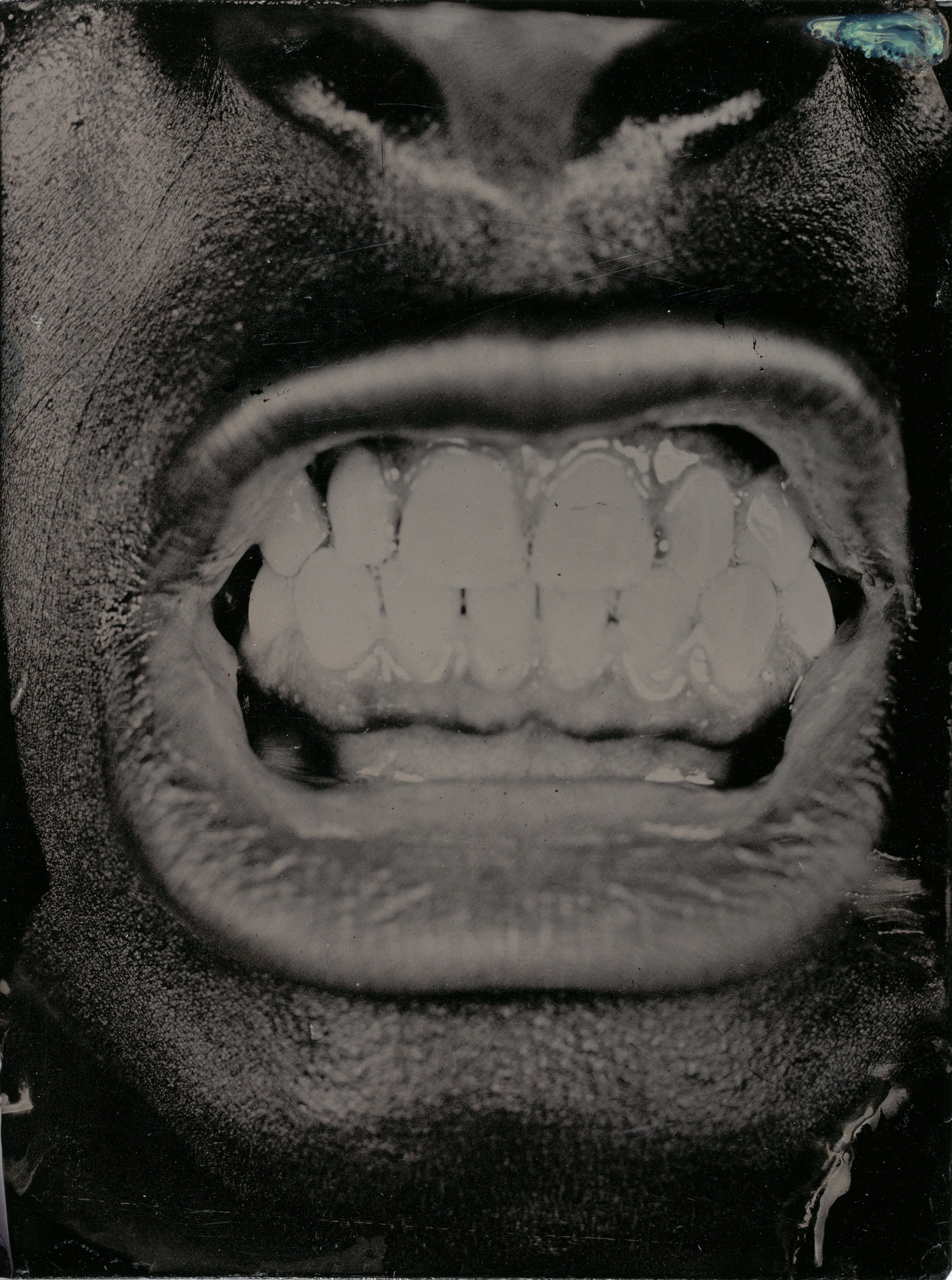
This close-upwardly self-portrait by Myra Greene addresses the complexity of how we encounter other people and what nosotros can know past seeing them. The photo isolates and fragments a part of Greene's face, denying the states the ability to meet her as a whole. The work intentionally uses a vintage photography technique called ambrotype to insinuate to a 19th-century version of racial profiling in which photography was used to allocate facial features to support white supremacy. This photograph is part of a series titled Grapheme Recognition. Greene began this project in 2006, noting, "Confronted with an upwardly bang-up of bigotry both personal and public, I was forced to ask myself, what practise people see when they look at me. Am I zip merely blackness? Is that skin tone enough to describe my nature and expectation in life?"
Could this piece of work be considered an deed of intersectional feminism? Why or why not?
Myra Greene,
26 of thirty
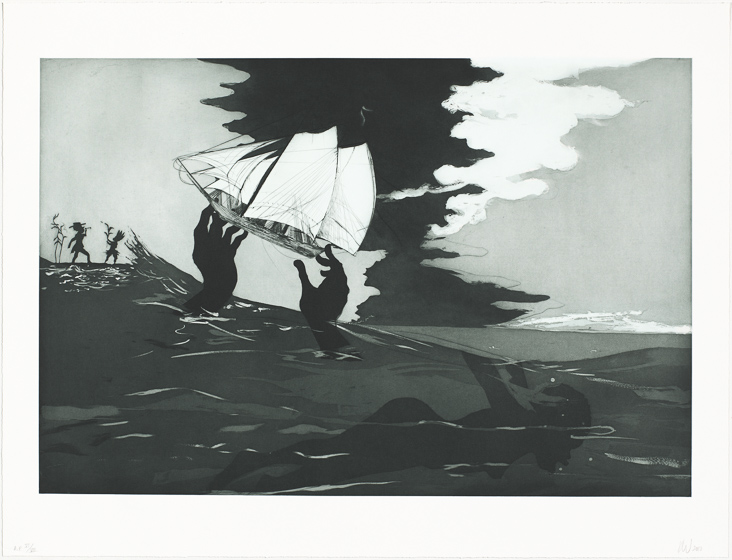
This etching is part of a series—An Unpeopled Land in Uncharted Waters—whose 6 works refer to the transatlantic slave trade. Its title, no earth, may exist a pun on "New World," referring to dislocation and an in-between state. The epitome, resembling an illustration from a graphic novel, communicates a narrative of mythological proportion. The sailing send, alluding to a vessel used in the forced transport of African people to the Americas, is being lifted out of heaving seas past behemothic black easily. A dramatic column of blackness and white clouds clash in the heaven to a higher place, suggesting disharmonize, while beneath the water, a floating female figure faces downwards. A long wave moves toward the shore, upon which stand two afar, caricatured silhouetted figures with some spindly plants, perhaps a reference to the 19th-century agricultural economy that depended on the labor of enslaved people. Kara Walker's piece of work addresses the violent, traumatic history of slavery and its legacy. A female person effigy is a prominent function of this work. Why might Walker have made the choice to include this figure, and to give her prominence in the foreground?
Kara Walker,
27 of thirty

Creative person Lee Seung-Hee adopted an Americanized proper noun, Nikki South. Lee, when she moved to the United states of america from South Korea. In this photograph, we see the fourth dimension-honored ritual of talking and applying makeup in the ladies' room. The image even has an orange time stamp that dates it to June 14, 1998.
Lee's photographs are a component of a larger, functioning-based project begun in New York City to explore a range of self-identifying cultures, some based on gender or race, others on intersecting music, fashion, or professional subcultures. Over a catamenia of months, Lee would assimilate herself into a detail group, forming relationships and edifice trust. Side by side, she transformed herself through dress, makeup, and gesture so that she appeared to be a fellow member of that culture. She and so documented her inclusion in the grouping by giving her betoken-and-shoot camera to one of her new friends. In this image, we encounter Lee in the foreground applying lip liner.
What questions does this image raise well-nigh group identity and acceptance, whether based on culture or gender?
Nikki S. Lee,
28 of thirty
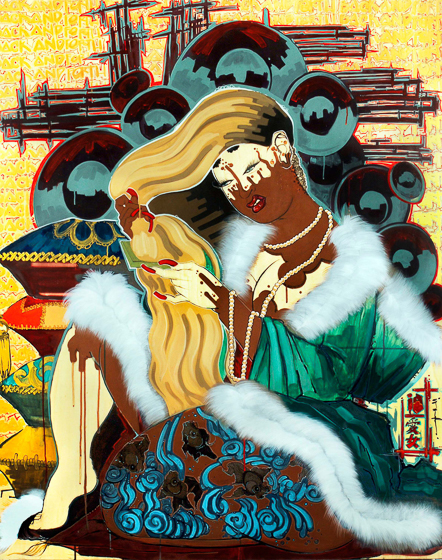
Rozeal uses the title of this piece of work, a play on Aphrodite, ancient Greek goddess of love and beauty, to present a cross-cultural rebellion on beauty ideals that traverses the Eastern and Western Hemispheres.
Rozeal spent fourth dimension in Japan through a fellowship program and became interested in the ganguro style, whereby immature Japanese women counter traditional beauty norms by wearing skin-concealment makeup, dying their long hair blonde, and applying long nail tips. Every bit a DJ and performance artist, Rozeal underscores ganguro'southward references to African American hip-hop civilization—seen in the words "back and forth" repeated in the background, a quotation from the vocal "Whip My Hair" by Willow Smith, while music discs frame the effigy. The stylized appearance and pose of the effigy remember Japanese 19th-century ukiyo-e prints, which traditionally depict a fantasy world of nightlife and geisha. What does beauty mean to you? What does this work of art make you recall about women in your own community and culture?
Rozeal (formerly known as iona rozeal brown),
29 of 30
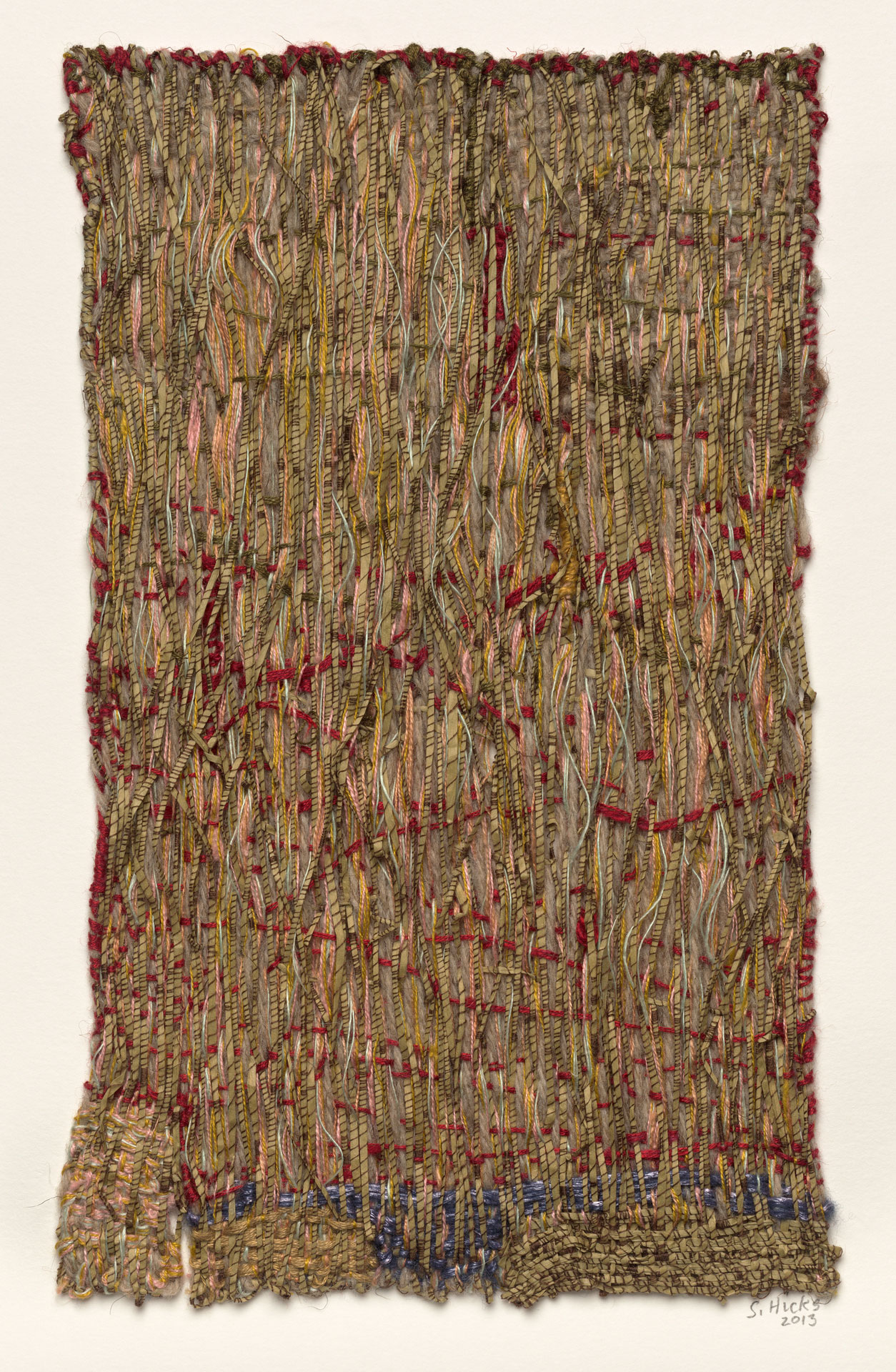
This frail piece of work, smaller than a standard canvas of paper, is carefully synthetic from fibers. Sheila Hicks has built a long career exploring the intersections between so-called fine art and textiles. In so doing, she has brought creative practices similar weaving and tapestry, which are often denigrated as crafts and women'southward piece of work, into the mainstream. Hicks enrolled at the Yale School of Fine art during the 1950s and studied with Josef Albers, an abstract artist and color theorist originally from Germany. As a student, Hicks also became acquainted with the work of Albers'south wife, Anni Albers, considered one of the foremost textile artists and designers of the 20th century. A grant to study painting in Chile sparked Hicks's interest in Indigenous textile traditions and led her to embark on a self-guided tour through every country of Due south America. During her nomadic career, she has developed fiber arts workshops in Mexico, Chile, and S Africa. Today she works largely from a studio in Paris. Hicks's work spotlights the time and labor that textile arts entail—hours spent in repetitive motions and gestures to create pliable forms that reveal the traces of their making. Although bound past their structure, her works frequently appear remarkably free and expressive. Modestly scaled works, such every bit, Embedded Thoughts, fabricated of narrow strips of fragile paper wrapped in tiny threads of silk, serve as "sketches" in which the creative person works through experimental ideas. Are at that place any traditions that have been passed down among women in your community or culture? Do you participate in these traditions? Why or why not?
Sheila Hicks,
30 of 30
Source: https://www.nga.gov/features/slideshows/women-art.html
Belum ada Komentar untuk "Folk Art Sketch of Girl With a Whip and a Dog"
Posting Komentar